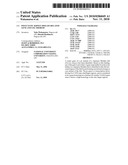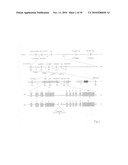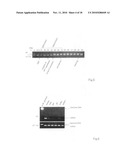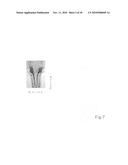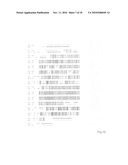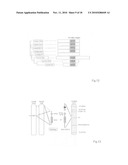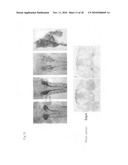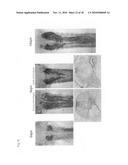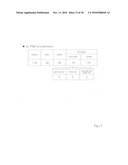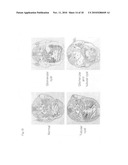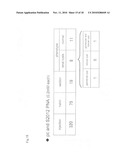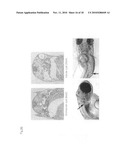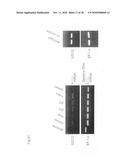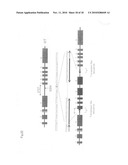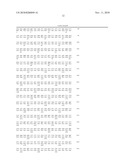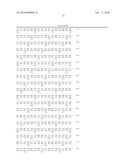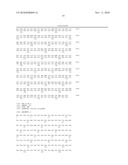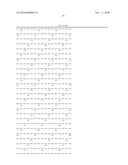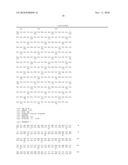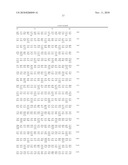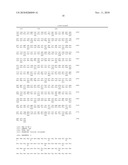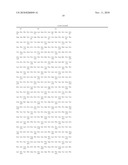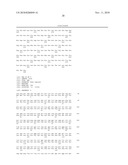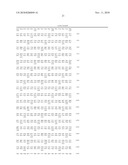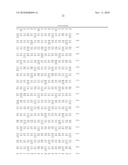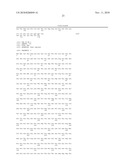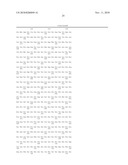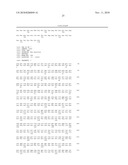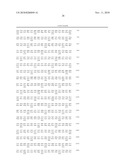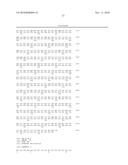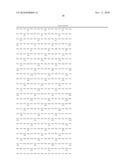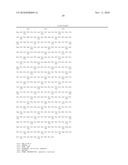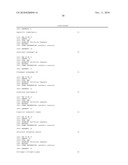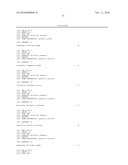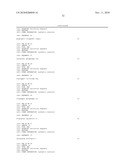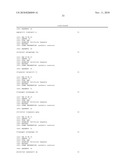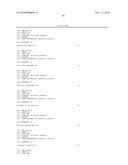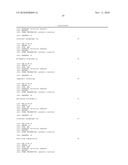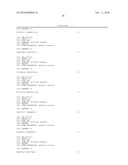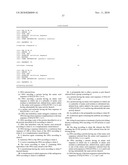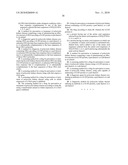Patent application title: POLYCYSTIC KIDNEY DISEASE-RELATED GENE AND USE THEREOF
Inventors:
Yuko Wakamatsu (Nagoya-Shi, JP)
Hisashi Hashimoto (Nagoya-Shi, JP)
Assignees:
NATIONAL UNIVERSITY CORPORATION NAGOYA UNIVERSITY
IPC8 Class: AA61K3817FI
USPC Class:
514 154
Class name: Designated organic active ingredient containing (doai) peptide (e.g., protein, etc.) containing doai kidney affecting
Publication date: 2010-11-11
Patent application number: 20100286049
Claims:
1. DNA selected from:(a) DNA encoding a protein having the amino acid
sequence of SEQ ID NO: 2 or 4;(b) DNA encoding a protein having an amino
acid sequence in which one or a plurality of amino acid residues is
substituted into, deleted from, and/or added to the amino acid sequence
of SEQ ID NO: 2 or 4, and having substantially the same activity
thereof;(c) a nucleic acid molecule having the base sequence of SEQ ID
NO: 1 or 3; and(d) DNA that hybridizes under stringent conditions with
DNA having a base sequence complementary to the base sequence of SEQ ID
NO: 1 or 3.
2. DNA encoding a part of the protein described in (a) or the protein described in (b) according to claim 1.
3. DNA that hybridizes with the nucleic acid molecule according to claim 1, or a complementary strand thereof.
4. DNA having a sequence identical to a continuous base sequence of 100 or fewer bases of the DNA according to claim 1, or a complementary strand thereof.
5. A detection agent containing the DNA according to claim 1.
6. Antisense DNA to the DNA according to claim 1.
7. A vector containing the DNA according to claim 1.
8. The vector according to claim 7, containing RNA equivalent to the DNA sense strand as the DNA.
9. A transformant having the vector according to claim 7 inserted therein.
10. A transformant in which expression of the endogenous DNA according to claim 1 is inhibited.
11. A polypeptide that is either a protein or part thereof selected from a group consisting of:(a) a protein having the amino acid sequence of SEQ ID NO: 2 or 4; and(b) a protein having an amino acid sequence in which one or a plurality of amino acid residues is substituted into, deleted from, and/or added to the amino acid sequence of SEQ ID NO: 2 or 4, and having substantially the same activity thereof.
12. An antibody to the polypeptide according to claim 11.
13. A detection agent containing the antibody according to claim 12.
14. A drug for prevention or treatment of polycystic kidney disease containing DNA encoding a GLIS3 protein or a part thereof.
15. The drug according to claim 14, wherein the DNA encoding the GLIS3 protein is DNA selected from the following group:(a) DNA encoding a protein having any of the amino acid sequences selected from the amino acid sequences of SEQ ID NOs: 2, 4, 6, and 8;(b) DNA encoding a protein having an amino acid sequence in which one or a plurality of amino acid residues is substituted into, deleted from, and/or added to any of the amino acid sequences selected from the amino acid sequences of SEQ ID NOs: 2, 4, 6, and 8, and having substantially the same activity thereof;(c) DNA having any of the base sequences selected the base sequences of SEQ ID NOs: 1, 3, 5, and 7; and(d) DNA that hybridizes under stringent conditions with a base sequence complementary to any of the base sequences selected the base sequences of SEQ ID NOs: 1, 3, 5, and 7.
16. A method for prevention or treatment of polycystic kidney disease comprising a step of administering an effective amount of DNA encoding a GLIS3 protein or part thereof to an animal.
17. A diagnostic agent for polycystic kidney disease containing DNA encoding a GLIS3 protein or a part thereof, or antisense DNA having a base sequence that is complementary to or substantially complementary to the base sequences of those DNA molecules.
18. A method for diagnosis of polycystic kidney disease containing DNA encoding a GLIS3 protein or a part thereof, or antisense DNA having a base sequence that is complementary to or substantially complementary to the base sequences of those DNA molecules.
19. A screening method for a drug for prevention or treatment of polycystic kidney disease that utilizes DNA encoding a GLIS3 protein or a part thereof, or antisense DNA having a base sequence that is complementary to or substantially complementary to the base sequences of those DNA molecules.
20. A screening method for a drug for prevention or treatment of polycystic kidney disease using cells that express a Glis3 gene.
21. A screening method for a drug for prevention or treatment of polycystic kidney disease using cells in which expression of a Glis3 gene is inhibited.
22. The screening method for a drug for prevention or treatment of polycystic kidney disease according to claim 21, using a transformant animal in which expression of a Glis3 gene is inhibited.
23. A drug for prevention or treatment of polycystic kidney disease containing a GLIS3 protein, a part thereof, or a salt thereof.
24. The drug according to claim 23, wherein the GLIS3 protein is:(a) a protein having any of the amino acid sequences selected from the amino acid sequences of SEQ ID NOs: 2, 4, 6, and 8; or(b) a protein having an amino acid sequence in which one or a plurality of amino acid residues is substituted into, deleted from, and/or added to any of the amino acid sequences selected from the amino acid sequences of SEQ ID NOs: 2, 4, 6, and 8 and having substantially the same activity thereof.
25. A method for prevention or treatment of polycystic kidney disease comprising a step of administering an effective amount of a GLIS3 protein, a part thereof, or a salt thereof to an animal.
26. A screening method for a drug for prevention or treatment of polycystic kidney disease using a GLIS3 protein, a part thereof, or a salt thereof.
27. A screening method for a drug for prevention or treatment of polycystic kidney disease, using cells capable of expressing a GLIS3 protein or a part thereof.
28. A diagnostic agent for polycystic kidney disease containing an antibody to a GLIS3 protein, a part thereof, or a salt thereof.
29. A diagnostic method for polycystic kidney disease utilizing an antibody to a GLIS3 protein, a part thereof, or a salt thereof.
Description:
TECHNICAL FIELD
[0001]The present invention relates to a protein having the activity of regulating the onset and progression, etc., of polycystic kidney disease, a nucleic acid molecule encoding the protein, and the uses thereof.
BACKGROUND ART
[0002]Many of the main organs in the bodies of animals comprise "tubes" as the basic unit thereof. Kidney is one such typical organ. However, the molecular mechanism underlying "tube" formation is barely understood.
[0003]Subtypes of polycystic kidney disease (PKD) in humans include autosomal recessive polycystic kidney disease (ARPKD) and autosomal dominant polycystic kidney disease (ARPKD). Among these subtypes, ADPKD is a widespread genetic disease, and it is estimated that 100,000 to 200,000 persons are afflicted with this disease in Japan. ADPKD is a systemic disorder that not only causes cysts in the kidneys, but also in the liver, pancreas, and spleen. The medical histories of ADPKD patients frequently include cerebral hemorrhage, etc., and hypertension is a complication thereof in more than half the cases. The formation of kidney cysts, which is the most striking feature of ADPKD, causes renal hypertrophy and diminished urine concentration capability. These symptoms progress with aging in ADPKD patients, and because no effective mode of therapy exists, ultimately the kidneys fail, necessitating dialysis and kidney transplantation. The pathology of cyst formation in ADPKD is manifested by hypertrophy of the renal tubes, i.e., an abnormality in the regulation and maintenance of tube diameters.
[0004]The PKD1 gene at location 16p13.3 on human chromosome 16 and the PKD2 gene at location 4q21-23 of human chromosome 4 have been identified as responsible genes of ADPKD, and these encode the proteins polycystin-1 (PC1) and polycystin-2 (PC2) respectively (Wilson P D, et al., N Engl J Med, 8 Jan. 2004, 350(2): 151-64). In addition, the responsible gene(s) have been cloned in a murine polycystic kidney disease model (Liang J D, et al., J Formos Med Assoc. June 2003, 102(6):367-74). It has been learned that these proteins are present in the cilia located at the tips of tubular epithelial cells, and it is predicted that tubule hypertrophy due to ciliary dysfunction is one of the cause of the onset of ADPKD (Boletta A, et al., Trends Cell Biol. September 2003; 13(9): 484-92, Review). However, the detailed mechanism of the onset of ADPKD is still unknown.
DISCLOSURE OF THE INVENTION
[0005]The inventors have discovered that there is a mutant medaka fish (Oryzias latipedes) that expresses a phenotype strongly resembling the pathology of human ADPKD (hereinafter, the medaka mutant is referred to as the medaka pc mutant). In this medaka pc mutant, hypertrophy of renal tubule diameter begins soon after hatching; the renal hypertrophy progresses together with aging, whereas the kidney weight in adults becomes at least 100-fold greater than in normal medaka, and death occurs a few months after hatching. The kidneys of this mutant are enormous and contain complex, branching cysts. The cells constituting the cysts exhibit the histological feature of squamous metaplasia, and their histology is remarkably similar to that of human ADPKD cells.
[0006]In general, the structure and function of organs in medaka and other small fish have a high degree of commonality with those in humans. With respect to the kidney, the medaka kidney has a plurality of nephron units comprising a glomerulus and proximal and distal tubules just as in humans. In addition, the genomic controls involved in kidney development in mammals are conserved in medaka. Moreover, with respect to the genome, not only are many genes in both humans and fish analogous, but synteny, i.e., the co-localization of a plurality of homologous genes in the same linkage group or on the same chromosome, also exists over a wide range of chromosomes. Furthermore, medaka have many merits in terms of research: their eggs are transparent, they lay eggs throughout the year in an artificial environment, the time between generations is relatively short; i.e. 2 to 3 months, they are easy to raise, and their maintenance costs are extremely low. Based on the above conditions, medaka can serve as a tube diameter regulation model in developmental biology, and also as a human disease model. More specifically, the medaka pc mutant is mesonephric and the mesonephros persists into adulthood, so it is expected to serve as the only good disease model for PKD among small fish.
[0007]However, in the course of their research the inventors learned that the renal tubule epithelial cells of the medaka pc mutant are ciliated, and no abnormalities were found in the expression of mRNA molecules encoding polycystin-1 and polycystin-2. They also discovered that a mutation in a new gene heretofore undiscovered in the medaka pc mutant may be the cause of the disease. It is expected that the identification of the responsible gene in the medaka pc mutant will contribute not only to understanding the "tube" forming control mechanism in animals, but also to understanding the mechanism of the onset of PKD in humans. Even more so, it is expected that identification of the responsible gene will contribute to the diagnosis and treatment of PKD in humans and other animals.
[0008]Thus, an object of the present invention is to identify the causative gene in the medaka pc mutant, and a further object of the present invention is not only to understand the mechanism of onset of PKD therein, etc., but also to search for a drug to treat PKD in animals and use such a drug in an agent for the diagnosis and treatment of PKD.
[0009]The inventors used positional cloning techniques in the medaka pc mutant to identify and isolate the gene responsible for polycystic kidney disease in medaka from its chromosomal region. In other words, the inventors identified the linkage group of the putative responsible gene (hereinafter, referred to as the pc gene) in the medaka pc mutant, and then prepared a high resolution chromosome map of the vicinity of the pc gene, began chromosome walking from the nearest marker, and identified a BAC clone straddling the pc gene locus. Next, shotgun cloning of that clone was performed and a comparison was made with the genome of the fugu puffer fish (Takifugu rubripes), and the potential pc gene locus was narrowed to two regions. Then, an expression analysis of these regions was performed in wild type and pc mutant medaka. Based on the evidence that an insertion or deletion mutation is present on the 3' end of one of the two aforementioned genes in the mutant and that the mRNA transcription product of that gene is not detected, etc., the gene causing that mutation was identified as the medaka pc gene. The pc gene is thought to be a transcription factor having five C2H2 zinc finger motifs, and based on the high level of homology in the zinc finger motifs, it is thought to be a homologue of the human Gli-similar3 (Glis3) gene. The present invention provides the following means. [0010](1). DNA selected from: [0011](a) DNA encoding a protein having the amino acid sequence of SEQ ID NO: 2 or 4; [0012](b) DNA encoding a protein having an amino acid sequence in which one or a plurality of amino acid residues is substituted into, deleted from, and/or added to the amino acid sequence of SEQ ID NO: 2 or 4, and having substantially the same activity thereof; [0013](c) a nucleic acid molecule having the base sequence of SEQ ID NO: 1 or 3; and [0014](d) DNA that hybridizes under stringent conditions with DNA having a base sequence complementary to the base sequence of SEQ ID NO: 1 or 3. [0015](2) DNA encoding a part of the protein described in (a) above or the protein described in (b) above. [0016](3) DNA that hybridizes with the nucleic acid molecule according to (1) or (2), or a complementary strand thereof. [0017](4) DNA having a sequence identical to a continuous base sequence of 100 or fewer bases of the DNA according to (1) or (2), or a complementary strand thereof [0018](5) A detection agent containing the DNA according to any of (1) to (4). [0019](6) Antisense DNA to the DNA according to (1) or (2). [0020](7) A vector containing the DNA according to (1) or (2). [0021](8) The vector according to (7), containing RNA equivalent to the DNA sense strand as the DNA. [0022](9) A transformant having the vector according to (7) or (8) inserted therein. [0023](10) A transformant in which expression of the endogenous DNA according to any of (1) to (4) is inhibited. [0024](11) A polypeptide that is either a protein or part thereof selected from a group consisting of: [0025](a) a protein having the amino acid sequence of SEQ ID NO: 2 or 4; and [0026](b) a protein having an amino acid sequence in which one or a plurality of amino acid residues is substituted into, deleted from, and/or added to the amino acid sequence of SEQ ID NO: 2 or 4, and having substantially the same activity thereof. [0027](12) An antibody to the polypeptide according to (11). [0028](13) A detection agent containing the antibody according to (12). [0029](14) A drug for prevention or treatment of polycystic kidney disease containing DNA encoding a GLIS3 protein or a part thereof. [0030](15) The drug according to (14), wherein the DNA encoding the GLIS3 protein is DNA selected from the following group: [0031](a) DNA encoding a protein having any of the amino acid sequences selected from the amino acid sequences of SEQ ID NOs: 2, 4, 6, and 8; [0032](b) DNA encoding a protein having an amino acid sequence in which one or a plurality of amino acid residues is substituted into, deleted from, and/or added to any of the amino acid sequences selected from the amino acid sequences of SEQ ID NOs: 2, 4, 6, and 8, and having substantially the same activity thereof; [0033](c) DNA having any of the base sequences selected the base sequences of SEQ ID NOs: 1, 3, 5, and 7; and [0034](d) DNA that hybridizes under stringent conditions with a base sequence complementary to any of the base sequences selected the base sequences of SEQ ID NOs: 1, 3, 5, and 7. [0035](16) A method for prevention or treatment of polycystic kidney disease comprising a step of administering an effective amount of DNA encoding a GLIS3 protein or part thereof to an animal. [0036](17) A diagnostic agent for polycystic kidney disease containing DNA encoding a GLIS3 protein or a part thereof, or antisense DNA having a base sequence that is complementary to or substantially complementary to the base sequences of those DNA molecules. [0037](18) A method for diagnosis of polycystic kidney disease containing DNA encoding a GLIS3 protein or a part thereof, or antisense DNA having a base sequence that is complementary to or substantially complementary to the base sequences of those DNA molecules. [0038](19) A screening method for a drug for prevention or treatment of polycystic kidney disease that utilizes DNA encoding a GLIS3 protein or a part thereof, or antisense DNA having a base sequence that is complementary to or substantially complementary to the base sequences of those DNA molecules. [0039](20) A screening method for a drug for prevention or treatment of polycystic kidney disease using cells that express a Glis3 gene. [0040](21) A screening method for a drug for prevention or treatment of polycystic kidney disease using cells in which expression of a Glis3 gene is inhibited. [0041](22) The screening method for a drug for prevention or treatment of polycystic kidney disease according to (21), using a transformant animal in which expression of a Glis3 gene is inhibited. [0042](23) A drug for prevention or treatment of polycystic kidney disease containing a GLIS3 protein, a part thereof, or a salt thereof. [0043](24) The drug according to (23), wherein the GLIS3 protein is: [0044](a) a protein having any of the amino acid sequences selected from the amino acid sequences of SEQ ID NOs: 2, 4, 6, and 8; or [0045](b) a protein having an amino acid sequence in which one or a plurality of amino acid residues is substituted into, deleted from, and/or added to any of the amino acid sequences selected from the amino acid sequences of SEQ ID NOs: 2, 4, 6, and 8 and having substantially the same activity thereof. [0046](25) A method for prevention or treatment of polycystic kidney disease comprising a step of administering an effective amount of a GLIS3 protein, a part thereof, or a salt thereof to an animal. [0047](26) A screening method for a drug for prevention or treatment of polycystic kidney disease using a GLIS3 protein, a part thereof, or a salt thereof. [0048](27) A screening method for a drug for prevention or treatment of polycystic kidney disease, using cells capable of expressing a GLIS3 protein or a part thereof. [0049](28) A diagnostic agent for polycystic kidney disease containing an antibody to a GLIS3 protein, a part thereof, or a salt thereof. [0050]29. A diagnostic method for polycystic kidney disease utilizing an antibody to a GLIS3 protein, a part thereof, or a salt thereof.
BRIEF DESCRIPTION OF THE DRAWINGS
[0051]FIG. 1 shows the genetic map of the candidate region of the pc mutation. In the figure, (a) represents a recombination map of linkage group 12, and (b) represents the start of chromosome walking using BAC with polymorphic marker AU171175 as the origin. The pc gene locus was approached in the sequence of BAC clones 184A3, 198E6, 201K4, and 174E15. The terminal sequence of each BAC insert was mapped, and these were named 184A3F, 231H8R, 201K4F, and 174E15R, respectively. The number of recombination between the pc gene locus and sequences 201K4F and 174E15R was 1 and 3, respectively, and it was confirmed that the pc gene locus is present on BAC clone BAC174E15. (c) shows the genes on BAC174E15 revealed by shotgun sequencing. From the left, the gene regions are pc, RFX3, SMAD4, BMP10, and catenin-ARVCF. (d) is the intron/exon structure of the wild type pc gene. The structure shows that the gene comprises at least 10 exons. It can be seen that exon 3 is spiced selectively. (d) shows that in the pc gene region of the pc mutant, exons 5-10 behind exon 4 are missing.
[0052]FIG. 2 shows the expression analysis of the mRNA of pc and c78 (RFX3). The mRNA was detected in medaka one month after hatching. A c80-67 primer set was used for pc and a c78 primer set was used for RFX3. In the pc mutant, pc mRNA was not detected.
[0053]FIG. 3 shows an expression map of pc mRNA. The pc mRNA was detected in the kidneys of the pc mutant and the OR strain (wild type) by northern blotting. A band seen in the OR strain was not found in the pc mutant.
[0054]FIG. 4 shows cDNA of the pc gene. The underlined portion is the selective splicing site. Two types of mRNA with different start codons are produced by selective splicing. The methionine due to each start codon is shown by an underline. In the pc mRNA of the pc mutant, the portion of exons 5-10 is changed to a "base sequence continuing behind exon 4 in the mutated pc mRNA of the pc mutant." The bases at the 3' and 5' ends of each exon are enclosed in rectangles, and a slash (/) is inserted to show the exon boundaries.
[0055]FIG. 5 shows time-course changes in pc mRNA in a medaka embryo. The upper band is pc and the lower band is a control (EF-1α).
[0056]FIG. 6 shows the organ distribution of pc mRNA in adult medaka. Total RNA prepared from kidney, liver, gut, gill, ovary, and spleen was investigated using RT-PCR.
[0057]FIG. 7 shows whole-mount in situ hybridization of pc mRNA. The photo shows the ventral view of a medaka at day 5 after hatching. The internal organs such as the gut, etc., have already been removed.
[0058]FIG. 8 shows a comparison of pc mRNA in the kidneys of the pc mutant and the OR strain. A comparison of the presence or absence of the regions amplified by the primer sets shown in the figure was performed by RT-PCR on total RNA prepared from the kidneys of the pc mutant and the OR strain (wild type).
[0059]FIG. 9 shows a comparison of the pc gene regions of the pc mutant and the OR strain. A comparison showing whether or not each region is amplified by the primer sets shown in the figure was made carrying out PCR on genomic DNA prepared from the pc mutant and the OR strain.
[0060]FIG. 10 shows a comparison of the amino acid sequences of the medaka pc and human Glis3 proteins. Matching and analogous amino acid residues are indicated by hatched areas.
[0061]FIG. 11 is a comparison of the zinc finger domains of the pc protein and other similar proteins. The C2H2 zinc finger domains of medaka S935, medaka S2012, human Glis1, human Glis3, medaka pc, human Gli2, human Glis2, and human Zic1 are extracted and compared.
[0062]FIG. 12 shows the level of homology of the zinc finger motifs and a phylogenetic tree of the pc protein and other analogous proteins.
[0063]FIG. 13 shows the synteny of the region surrounding the medaka pc gene with regions on human chromosome 9 and mouse chromosome 19.
[0064]FIG. 14 describes the mRNA probe sites using whole-mount in situ hybridization. The top row is wild type pc mRNA and the bottom row is pc mRNA from the pc mutant.
[0065]FIG. 15 shows the results of investigating the expression of pc mRNA in the wild type medaka kidney using whole-mount in situ hybridization. The top row shows ventral photographs of the medaka kidney region at 0, 5, 20, and 30 days after hatching. The bottom row shows photographs of anterior cross-sections at day 5 after hatching. Arrows 1 and 2 in the top row correspond to sections 1 and 2 on the bottom row.
[0066]FIG. 16 shows the results of investigating the expression of pc mRNA in the pc mutant medaka kidney. The top row shows ventral photographs of the medaka kidney region at 0, 5, and 10 days after hatching. The bottom row shows anterior photographs of anterior cross-sections at day 5 after hatching. The left shows a strong phenotype individual and the right shows a weak phenotype individual. Arrows 1 and 2 in the top row correspond to sections 1 and 2 on the bottom row.
[0067]FIG. 17 shows the phenotype statistics when the pc gene is knocked down with an antisense oligonucleotide. Twenty-five individuals were randomly selected from hatched individuals, and the renal histology thereof was examined.
[0068]FIG. 18 shows examples when the phenotype manifested by pc knockdown is classified by site of cyst formation. The arrows show glomerular cysts, and the asterisks (*) show tubular cysts.
[0069]FIG. 19 shows the phenotype statistics for a pc and S2012 (glis1) double knockdown. Even under the dissecting microscope before sectioning, cysts could be seen in all 8 individuals with this phenotype.
[0070]FIG. 20 shows one example of the phenotype manifested by the pc and S2012 (glis1) double knockdown when classified by site of cyst formation. In the top row the arrows show glomerular cysts, and the asterisks (*) show tubular cysts. In the bottom row the arrows show cysts that can be recognized even under a dissecting microscope.
[0071]FIG. 21 shows the organ distribution of S2012 mRNA in adult medaka. Total RNA prepared from kidney, liver, gut, gill, ovary, and spleen was investigated using RT-PCR.
[0072]FIG. 22 shows the pc mutation caused by insertion of a transposon.
[0073]The transposon is inserted at the 5264th base from the 5' side of intron 4 (5727 bases long). The arrow shows the repeat sequences at the ends of the transposon.
BEST MODE FOR CARRYING OUT THE INVENTION
[0074]The present invention is described more in detail below.
[0075]The present invention provides polynucleotide encoding a polypeptide involved in polycystic kidney disease (PKD) and causing the onset or progression thereof, the polypeptide itself, and the uses thereof. As noted above, the inventors have identified the medaka pc gene, i.e. the responsible gene of PKD in medaka, that was isolated using positional cloning.
[0076]In the medaka pc mutant used in the present invention, a deletion or insertion has occurred due to transposition at the 3' end of the pc gene that had been isolated by the inventors, and therefore the original polypeptide thereof is not expressed in the pc mutant. In a normal medaka, the pc gene is strongly expressed in the kidneys of adults. In other words, it has been confirmed that the pc gene has the activity of regulating the onset and/or progression of PKD. Therefore, it is possible to use the pc gene to search for novel drugs that can be used to elucidate the organ-forming mechanism, and the onset and progression of PKD, and to search for new drugs to treat PKD.
[0077]The cDNA base sequences of the pc gene are shown in SEQ ID NOs: 1 and 3, and the amino acid sequences of the polypeptides encoded thereby are shown in SEQ ID NOs: 2 and 4, respectively. These two species of polypeptides originate due to selective splicing from the same genome of the medaka pc gene.
[0078]The amino acid sequences of the pc proteins represented by SEQ ID NO: 2 and SEQ ID NO: 4 are both zinc finger type transcription factors having five C2H2 zinc finger motifs. These proteins are 48% and 49% homologous, respectively, with the human Gli-similar3 (GLIS3) protein, and are 50% and 52%, homologous, respectively, with the mouse GLIS3 protein. The homology between animal species is particularly high in the zinc finger motifs, and the homology between the pc protein (both pc-a and pc-b) and the human GLIS3 protein is 87.4% in these regions. This is significantly higher homology than the homology with other related zinc finger family members Gli and Zic, and this finding supports the belief that the medaka pc gene is a homologue of the human Glis3 gene. In addition, the human Glis3 gene is neither identical to nor homologous with the PKD 1 gene or PKD2 gene, which have been identified as the causative genes of PKD. Therefore, the Glis3 gene is a novel causative gene of PKD. In this description, the term "Glis3 gene" refers to a gene encoding the GLIS3 protein.
(Polynucleotide)
[0079]The polynucleotide of the present invention is defined as a polynucleotide having the base sequence of SEQ ID NO: 1 or SEQ ID NO: 3, and as a polynucleotide encoding a polypeptide having the amino acid sequence of SEQ ID NO: 2 or SEQ ID NO: 4.
[0080]The polynucleotide of the present invention includes a polynucleotide encoding a homologous gene in a human or other animal that has a high level of homology with the amino acid sequence of SEQ ID NO: 2 or SEQ ID NO: 4. The polypeptide encoded by the base sequence of SEQ ID NO: 1 or 3 of the present invention is a zinc finger type transcription factor, and based on the high level of homology in the zinc finger regions thereof, is a homologue of the human Gli-similar3 (Glis3) gene. It is also a homologue with the mouse Glis3 gene. SEQ ID NO: 6 shows the amino acid sequence of the human GLIS3 protein, and SEQ ID NO: 7 shows the amino acid sequence of the mouse GLIS3 protein. Therefore, the polynucleotide of the present invention includes a polynucleotide having the base sequence of SEQ ID NO: 5 or 7 and a polynucleotide encoding a protein having the amino acid sequence of SEQ ID NO: 6 or 8. Utilization of the human and mouse Glis3 gene is effective for the detection, diagnosis, screening for drugs, and treatment related to PKD in humans, mice, and other mammals.
[0081]The polynucleotide of the present invention also includes a polynucleotide encoding a protein having an amino acid sequence identical to an amino acid sequence of SEQ ID NOs: 2, 4, 6, and 8, or an amino acid sequence substantially identical thereto.
[0082]The polynucleotide of the present invention also includes a polynucleotide encoding a protein wherein 1 or a plurality of amino acid residues is substituted into, deleted from, and/or added to an amino acid sequence of SEQ ID NO: 2, 4, 6, or 8 as a protein having an amino acid sequence substantially identical thereto, and having substantially the same activity as a protein having the original amino acid sequence thereof The term "substantially the same activity" includes PKD regulatory activity, etc. The extent of the activity thereof is not particularly limited herein. It is possible that such a polynucleotide will be discovered as naturally occurring in a mutant, in other medaka species and small fish, and in other animal species.
[0083]A nucleic acid molecule encoding a protein with a modified amino acid sequence can be artificially prepared, and the methods therefor are well known to persons skilled in the art. It is possible, for example, to use a commercially available kit therefor. For example, such preparation can be carried out using a "Transformer Site-directed Mutagenesis Kit" and "ExSite PCR-Based Site-directed Mutagenesis Kit" (Clontech Laboratories) for mutation or substitution, and a "Quantum Leap Nested Deletion Kit" (Clontech Laboratories) for deletion. The number of amino acid residues deleted, substituted or added by a well-known method such as site-directed mutagenesis and the like can range from 1 to several dozen; preferably 1 to 20, more preferably 1 to 10, and even more preferably 1 to 5. Preferably, the modification of amino acids will involve conservative substitution. The DNA of the present invention also includes degenerative mutants.
[0084]Amino acid sequences that are substantially identical to a protein having an amino acid sequence of SEQ ID NO: 2, 4, 6, or 8 include, for example, an amino acid sequence having 50% or more homology with any of the amino acid sequences of SEQ ID NOs: 2, 4, 6, and 8, more preferably 60% or more homology, even more preferably 70% or more homology, and even more preferably 80% or more homology; furthermore, a sequence with 90% or more homology is even more preferred, and one with 95% or more homology is most preferred. The level of homology in the zinc finger region is preferably 70% or more, more preferably 75% or more, even more preferably 80% or more, and most preferably 90% or more.
[0085]The polynucleotide of the present invention also includes a polynucleotide capable of hybridizing under stringent conditions with DNA or another polynucleotide complementary to a base sequence of SEQ ID NO: 1, 3, 5, or 7. The term "polynucleotide capable of hybridizing under stringent conditions" refers to a nucleic acid molecule obtained using colony hybridization, plaque hybridization, or Southern blot hybridization, etc., using DNA, etc., comprising the base sequence of SEQ ID NO: 1, 3, 5, or 7 or a part thereof as a probe. More specifically, this includes DNA that can be identified by performing hybridization at 42° C. in the presence of 50% formamide, 6× Denhardt solution, 5×SSC solution, and 1% SDS using a filter having DNA from a colony or plaque immobilized thereon, and then rinsing the filter with 0.2×SSC solution under the condition of 65. The hybridization can be performed by following the methods described in Molecular Cloning, A Laboratory Manual, Second Edition, Cold Spring Harbor Laboratory Press (1989) (hereinafter, abbreviated as Molecular Cloning, Second Edition), Current Protocols in Molecular Biology, John Wiley & Sons (1987-1997) (hereinafter, abbreviated as Current Protocols in Molecular Biology), or DNA Cloning 1: Core Techniques, A Practical Approach, Second Edition, Oxford University (1995), etc. The hybridizable DNA specifically includes DNA having a base sequence that is at least 60% or more homologous with a base sequence of SEQ ID NO: 1, 3, 5, or 7 when calculated using BLAST [J. Mol. Biol., 215, 403 (1990)] and FASTA [Methods in Enzymology, 183, 63-98 (1990)], etc., preferably DNA having 70% or more homology, more preferably DNA having 80% or more homology, even more preferably DNA having 90% or more homology, and most preferably DNA having 95% or more homology.
[0086]The polynucleotide of the present invention can be obtained by using polymerase chain reaction (PCR) techniques (Saiki R K, et al., Science 230: 1350, 1985 and Saiki R K, et al., Science 239: 487, 1988). Based on these techniques, the inventors were able to isolate polynucleotides encoding polypeptides having a high level of homology with the polypeptide of the present invention from other small fish and other animals by using oligonucleotides based on the base sequence of the polynucleotide of the present invention (SEQ ID NOs: 1, 3, 5, or 7) or a part thereof.
[0087]The term that a "polypeptide has PKD regulatory activity" means that the polypeptide has the activity that circumvents or inhibits the onset and progression of PKD in animals or has the activity that enables normal kidney function to be expressed. Whether or not a polypeptide has such regulatory activity can be determined by a functional complementation test based on expression of the polypeptide in the pc mutant. It can also be determined by the screening method described below.
[0088]The polynucleotide of the present invention can also be a part of the aforementioned polynucleotide. In other words, the polynucleotide of the present invention includes a polynucleotide encoding proteins having the amino acid sequences of SEQ ID NO: 2, 4, 6, or 8, and parts of proteins that are substantially identical thereto. That is because a part of the encoded polypeptide may have PKD regulatory activity, or PKD regulatory may not be necessary for use thereof in the reagent, diagnostic agent, etc., as will later be described below.
[0089]The polynucleotide of the present invention also includes a polynucleotide that can hybridize with the above polynucleotide or its complementary strand. Such a hybridizable polynucleotide can be used as a probe in hybridization technology and as a primer in PCR technology, and can be used in a variety of diagnostic, detection, screening, and other methods based on those technologies. For hybridization the polynucleotide of the present invention does not need to be entirely complementary with the base sequence of the polynucleotide of which is the target of hybridization, and as such it being substantially complementary will suffice. The term "substantially complementary" means that it must be complementary to the extent that it can specifically hybridize with at least one part of the base sequence of the polynucleotide being the target of hybridization. The polynucleotide of the present invention can be a nucleic acid molecule having a sequence identical to a base sequence consisting of 100 or fewer continuous bases of such a nucleic acid molecule or its complementary strand. Preferably, it will be 60 or fewer bases long, and more preferably 40 or fewer bases long. On the other hand, preferably it will be 5 or more bases long, more preferably 10 or more bases long, and even more preferably 15 or more bases long.
[0090]DNA, or mRNA and other species of RNA can serve as the polynucleotide of the present invention, and it can be either double-stranded or single-stranded. If it is double-stranded, it can be double-stranded DNA, double-stranded RNA or a DNA/RNA hybrid. If it is single-stranded, the polynucleotide can also be an antisense strand. DNA encoding the GLIS3 protein can be genomic DNA, cDNA, synthesized DNA, or a genomic DNA library or cDNA library. Thus, various types of DNA molecules and RNA molecules corresponding thereto such as mRNA, etc., are included herein. Preferably the polynucleotide of the present invention is DNA. When the term "DNA or RNA of the present invention" is used below, it refers to a case wherein the polynucleotide of the various modes of the present invention is either DNA or RNA.
(Antisense Polynucleotide)
[0091]The antisense polynucleotide of the present invention is a polynucleotide that is identical to the complementary strand of the polynucleotide of the present invention or part thereof, or one that is substantially complementary to the polynucleotide of the present invention or part thereof. By the insertion thereof into a cell, the antisense nucleic acid molecule can inhibit the expression of that nucleic acid molecule. Chemical modification on such an antisense DNA molecules and antisense RNA molecule can be performed to make the breakdown thereof in the body more difficult, or to enable passage through the cell membrane. Such molecules can also be configured into a construct containing a DNA molecule that enables expression of an antisense RNA molecule in the body. The antisense nucleic acid molecule does not need to be 100% complementary to the targeted RNA, etc., however, it is preferably for it to be 90% or more complementary, and most preferably 95% or more complementary.
(Polypeptide)
[0092]The present invention provides a polypeptide having regulatory activity toward PKD. Such a polypeptide not only includes a protein having the amino acid sequence of SEQ ID NOs: 2 or 4, but also a protein encoded by the Glis3 gene, which is a homologue of the medaka pc gene. Examples thereof include a protein having the amino acid sequence of the Glis3 protein in humans (SEQ ID NO: 6) and in mice (SEQ ID NO: 8).
[0093]The polypeptide of the present invention includes those having an amino acid sequence wherein 1 or a plurality of amino acid residues is substituted into, deleted from, and/or added to those amino acid sequences, and having substantially the same activity as the original protein. In the present invention the proteins having the amino acid sequences of SEQ ID NOs: 2, 4, 6, or 8, and the aforementioned proteins are all grouped together and referred to as the GLIS3 protein. Not only can a protein having such a modified amino acid sequence be obtained by a variety of publicly known methods, but it can also be obtained as a recombinant protein by carrying out gene recombination techniques using the DNA molecule of the present invention. Preferably the polypeptide of the present invention will have substantially the same activity as the protein having one of the original amino acid sequences. The term "substantially the same activity" refers to regulatory activity, etc., of PKD, and the determination thereof has already been described.
[0094]A protein having an amino acid sequence wherein 1 or more amino acid residues is substituted into, deleted from, and/or added to the amino acid sequence of SEQ ID NOs: 2, 4, 6, or 6 can be obtained using the site-directed mutagenesis methods described in Molecular Cloning, Second Edition; Current Protocols in Molecular Biology; Nucleic Acids Research, 10, 6487 (1982); Proc. Natl. Acad. Sci. USA, 79, 6409 (1982); Gene, 34, 315 (1985); Nucleic Acids Research, 13, 4431 (1985); Proc. Natl. Acad. Sci. USA, 82, 488 (1985); etc., by introducing a site-directed mutation into DNA encoding a polypeptide having the amino acid sequence of SEQ ID NO: 2 or 4, for example. The number of amino acid residues deleted, substituted or added is not particularly limited herein, and a number that can be deleted, substituted, or added by a well-known method such as site-directed mutagenesis and the like can range from 1 to several dozen, but preferably will be 1 to 20, more preferably 1 to 10, and even more preferably 1 to 5. In addition, with respect to the extent of these amino acid deletions, substitutions or additions, the modified amino acid sequence will have homology of at least 60% or more, preferably 80% or more, more preferably 90% or more, and even more preferably 95% or more with the original amino acid sequence. The level of homology in the zinc finger region is preferably 70% or more, more preferably 75% or more, even more preferably 80% or more, and most preferably 90% or more.
[0095]The polypeptide of the present invention may also be a partial protein thereof. The number of amino acid residues in this mode of the polypeptide is not particularly limited herein, but preferably it has an amino acid sequence that is identical to or substantially identical to the amino acid sequence of the original protein and has substantially the same activity thereof. The term "substantially identical to the amino acid sequence" means that it has an amino acid sequence of which 1 or a plurality of amino acid residues is substituted into, deleted from, and/or added to an amino acid sequence of SEQ ID NO: 2, 4, 6, or 8, and the term "substantially the same activity" means the same as defined above.
[0096]The polypeptide of the present invention can be obtained not only by producing the same from animal cells or tissues using prior art, publicly known protein purification methods, but also by culturing a transformant that has been transformed by DNA encoding the same. In addition, it can be obtained by a prior art, publicly known chemical synthesis method.
[0097]The polypeptide of the present invention includes a GLIS3 protein or a partial salt thereof. The form of the salt is not particularly limited herein, but a pharmaceutically acceptable salt is preferred. Examples of the salt include the salts of hydrochloric acid, phosphoric acid, sulfuric acid and other inorganic acids, and the salts of acetic acid, citric acid, succinic acid, methanesulfonic acid, and other organic acids.
(Antibody)
[0098]The antibody of the present invention is an antibody that recognizes the GLIS3 protein of the present invention or a part thereof. The antibody of the present invention includes both monoclonal antibodies and polyclonal antibodies. The antibody of the present invention can be prepared by conventional methods using the protein of the present invention or a part thereof as an antigen for antibody production. The antibody of the present invention can be used not only to purify the protein of the present invention, but can also be used to detect and quantify the protein of the present invention by western blotting, ELISA, immunofluorescence techniques, and the like, and to detect the localization thereof in cells and the body. It is possible to search for the protein of the present invention and proteins similar to such by using the antibody of the present invention. The antibody can also be synthesized by a peptide synthesizer based on SEQ ID NOs: 2, 4, 6, or 8.
(Detection Agent)
[0099]The polynucleotide and antisense polynucleotide in the various modes of the present invention noted above can be used as an agent to detect the Glis3 gene. Examples include DNA or a part thereof encoding a protein having an amino acid sequence that is identical to or substantially identical to the amino acid sequence of SEQ ID NO: 2 or 4, DNA or a part thereof having a base sequence identical to or substantially identical to the base sequence of SEQ ID NO: 1 or 3, and a complementary strand thereto or DNA having a substantially complementary base sequence thereto. Such a detection agent can hybridize specifically with the targeted nucleic acid molecule or part thereof and be used as a probe to detect or isolate the polynucleotide of the present invention, or it can be used as a primer to amplify the same. By linking the nucleic acid to a dye, fluorescent dye, radioisotope or a linking group thereto, etc., and configuring the same so that a signal change will be generated either directly or indirectly by hybridization, whereby the presence or absence of expression of that nucleic acid molecule, and the extent of the expression thereof can be visualized through hybridization with such a probe in tissues and cells. The target of detection can be the DNA of the Glis3 gene, the mRNA transcription product thereof or other type of RNA, or cDNA.
[0100]The aforementioned antibody of the present invention can also be used as a detection agent to detect the GLIS3 protein. For example, an antibody to a protein or part thereof having an amino acid sequence identical to or substantially identical to the amino acid sequence of SEQ ID NO: 2 or 4 is a preferred detection agent for those polypeptides. Such an antibody can also be used to isolate the polypeptide of the present invention. Furthermore, by linking the antibody of the present invention to a dye, fluorescent dye, radioisotope or a linking group thereto, etc., the protein of the present invention can be detected and quantified by western blotting, ELISA, immunofluorescence techniques, and the like.
(Diagnostic Method and Diagnostic Agent for PKD)
[0101]The various modes of polynucleotide and antisense polynucleotide of the present invention can be used for the diagnosis of PKD. In accordance with this diagnostic agent, an abnormality in the Glis3 gene and the presence or absence of the expression product thereof, as well as abnormalities therein and the extent thereof, can be measured from a variety of samples such as blood, serum, urine, tissue, cells, etc., collected from the individual to be diagnosed or a nucleic acid extract thereof, Furthermore, it is thereby possible to diagnose whether the individual has PKD or not, and also the extent of the condition. For example, in cases where there is an abnormality in the Glis3 gene and the mRNA thereof, and in cases where the level of mRNA is decreased, it is possible to diagnose that the onset of PKD is possible, or that the condition of PKD has progressed. In such measurements the cDNA, mRNA, and other polynucleotides in the sample can be analyzed by plaque hybridization, colony hybridization, Southern blotting, northern blotting, RT-PCR, DNA chip or DNA microarray, etc. Furthermore, PKD can be diagnosed by a sequence comparison (including detection of restriction enzyme sites) between the human Glis3 gene or another polynucleotide of the present invention and cDNA extracted from the individual to be diagnosed.
[0102]The antibody of the present invention can be used for the diagnosis of PKD. In accordance with this diagnostic agent containing the antibody of the present invention, the presence or absence of these proteins and the content thereof can be measured from a variety of samples such as blood, serum, urine, tissue, cells, etc., collected from the individual to be diagnosed or a nucleic extract thereof, and it is possible to diagnose whether the individual has PKD or not, and the extent of the condition. ELISA, western blotting, immunofluorescence, and tissue staining can be used for such measurements. An antibody chip can also be used therefor.
(Vector)
[0103]The vector of the present invention incorporates the DNA of the present invention or the antisense DNA of the present invention. In accordance with a vector containing the DNA of the present invention and configured to express the GLIS3 protein or part thereof, the DNA of the present invention capable of expressing the GLIS3 protein can be carried by animal cells, small fish, or an animal. In accordance with a vector configured to express the antisense DNA of the present invention, expression of the Glis3 gene can be inhibited in cells transfected therewith. The vector can contain the sense strand of the DNA of the present invention, or an equivalent RNA molecule. Such RNA is preferably used in an RNA virus vector. The configuration of the vector can be suitably selected in accordance with the insertion thereof, etc., into the type of cells or host to be transfected with the vector.
(Transformant)
[0104]The transformant of the present invention includes a transformant carrying the exogenous DNA of the present invention. Such a transformant can be used for production of the polypeptide of the present invention and for screening for drugs for PKD.
[0105]The cells serving as the transformant are not particularly limited herein, and both microbial cells and animal cells can be used as needed. In a case where it is intended to manufacture the GLIS3 protein, there may be cases in which usage of microorganisms is effective because of their productivity.
[0106]By inserting a vector configured to express the GLIS3 protein or part thereof into a suitable host, it is possible to obtain a transformant that produces the GLIS3 protein or part thereof. Such a transformant can be used not only to produce the GLIS3 protein, but also to screen for drugs for the prevention and treatment of PKD.
[0107]In addition, a transgenic animal expressing the GLIS3 protein or a part thereof can be prepared by employing a vector configured to express the GLIS3 protein or a part thereof in a publicly known technique for preparing a transgenic animal. Such a transgenic animal will express a high level of the GLIS protein, and will be useful for elucidating the pathology of PKD and other diseases linked to the GLIS3 protein, and the action of the GLIS3 protein. Furthermore, based on the base sequence of the Glis3 gene, a knockout animal in which expression of the Glis3 gene is inhibited (or destroyed) can be prepared. Such a knockout animal will be useful as a PKD disease model animal, and screening for drugs for the prevention or treatment of PKD can be carried out using that disease model animal. Additionally, by inserting a reporter gene into the structural gene member of the Glis3 gene, a knockout animal wherein the reporter gene is expressed by the Glis3 promoter can be prepared. In accordance with such a knockout animal, screening for a compound or salt thereof that promotes or inhibits Glis3 promoter activity can be carried out by detecting the level of expression of the reporter gene. Examples of the reporter gene include GFP and other fluorescent protein genes, the lacZ gene, soluble alkaline phosphatase gene, luciferase gene, etc.
[0108]Examples of such a transgenic animal and knockout animal include nonhuman mammals such as rabbit, dog, rat, mouse, cow, pig, goat, hamster, etc. Examples of a knockout animal and gene-substituted animal include the aforementioned nonhuman mammals, and among these the mouse is preferred. As the knockout animal and gene-substituted animal, the medaka or another small fish used in research and testing is preferred, and the cells of zebra fish, medaka, goldfish, loach (Misgurnus anguillicaudatus), fugu puffer fish (Takifugu rubripes), etc., are even more preferred. Among the above, fish belonging to the genus Oryzias and related genera, including the transparent medaka disclosed in Japanese Patent Application Laid-open No. 2001-328480, are suitable for various model fish, etc.
[0109]Furthermore, prior art, publicly known methods can be used for the methods of configuring a vector and a targeting vector to construct a transgenic animal, knockout animal, and gene-substituted animal, and for the methods of inserting DNA into nonhuman animal ES cells, unfertilized eggs, fertilized eggs, primordial germ cells, etc.
[0110]Additionally, the present invention makes it possible to obtain a knockdown animal wherein the endogenous Glis3 gene is inactivated. An antisense nucleic acid that inhibits DNA transcription or inhibits translation to a protein can be used for inactivation of an endogenous gene. In addition, RNA and DNA based on ribozyme and RNAi means, and RNA and DNA based on caging techniques can also be used for inhibiting the expression of an endogenous gene. Furthermore, an aptamer, peptide nucleic acid, and the like can also be used. Just as in the case of the knockout animal, such a knockdown animal will be useful as a PKD model animal.
(Screening Method for Drugs for Prevention or Treatment of PKD)
[0111]The screening method for drugs according to the present invention enables a compound or salt thereof that can compensate for a deficiency of the GLIS3 protein and be used for the treatment of PKD to be obtained by exposing a test compound to a nonhuman PKD model animal such as a medaka, mouse, etc., or animal cells wherein expression of the Glis3 gene is inhibited, and observing whether the formation of cysts is inhibited in the model animal, or whether the formation of cysts and pathology progress. Moreover, by using microorganisms, animal cells, etc., that have been transformed to express the polynucleotide of the present invention, it is possible to detect a target compound that binds specifically to these transformants or to the transcription product of that polynucleotide. Furthermore, it is possible thereby to detect a protein specifically expressed in such a transformant. Additionally, by synthesizing a protein in a cell-free system using that nucleic acid molecule, it is possible to detect a target compound that binds specifically to that protein. Screening for a drug that can be used to prevent or treat PKD can be carried out by detecting such proteins and low molecular weight compounds.
[0112]The protein of the present invention and antibody thereto can be used in the drug screening method of the present invention. By using the protein of the present invention or a part thereof, and screening for substances that bind thereto and substances that regulate the expression and activity thereof, it will be possible to discover drugs that cause the protein of the present invention to be expressed or promote the function thereof. Drugs that promote the expression of the protein of the present invention can be discovered by screening for substances that regulate the expression of the protein of the present invention with ELISA and flow cytometry utilizing the antibody of the present invention. A substance that causes the protein of the present invention to be expressed or that enhances the activity thereof can be expected to provide a novel drug for PKD, including ADPKD.
(Drug for Prevention or Treatment of PKD)
[0113]The drug for the prevention or treatment of PKD according to the present invention can contain the DNA of the present invention, and preferably is a vector configured to express the GLIS3 protein or a part thereof. The drug can also contain a suitable base substance for a gene therapy drug. More specifically a vector containing a base sequence encoding cDNA of the human Glis3 gene is a preferred gene therapy drug for the prevention or treatment of human PKD. This gene therapy drug can cause expression of the Glis3 gene in a PKD patient, can inhibit or circumvent the onset of ADPKD and other forms of PKD by producing the protein as the product thereof, and can control the pathological progression of PKD, or can cure PKD. In addition, the drug for the prevention or treatment of PKD according to the present invention can contain the polypeptide of the present invention or part thereof, or an antibody thereto. With such a drug it will be possible to supplement the deficiency of the GLIS3 protein or part thereof and impart the original function of the GLIS3 protein. Such a drug can contain one or a plurality of pharmacologically acceptable carriers.
EXAMPLE 1
[0114]The present invention is described in detail below through examples, but the present invention is by no means limited thereto.
(Medaka Phylogenetic Analysis)
[0115]A phylogenetic analysis (846 individuals) was carried out using sibling mating between the progeny of the medaka pc mutant (hereinafter, also referred to as pc), which is the medaka strain wherein PKD occurs, and progeny of the HNI(+/+) inbred strain. The BAC gene library used for screening originated in the Hd-rR (+1+) inbred strain. This BAC gene library was obtained from professor Hiroshi Hori, Graduate School of Science, Nagoya University.
(Genetic Analysis)
[0116]After the BAC DNA was purified by a conventional mini-prep protocol, the BAC terminal was directly sequenced and mapped. After BAC174E15 was sheared using a HydroShear, the small DNA fragments were fractionated and removed using a Sep 400 Spun Column/Sepharose CL-4B (Amersham), and subcloned with PUC18 plasmids. A BAC174E15 shotgun library was prepared by inserting the plasmids into E. coli DH1OB cells using electroporation. Colonies were randomly selected and sequenced using an Applied Biosystems Model 377 Automated DNA Sequencer.
(Polymorphism Analysis)
[0117]By using 9% polyacrylamide gel electrophoresis (PAGE), it was verified whether or not the DNA fragments of different sizes would be amplified by PCR using genomic DNA of the medaka HNI strain, pc strain, and a crossbred strain thereof. When no size differences were found among the above 3 strains, each PCR product was additionally subjected to a restriction enzyme treatment, and the differences in the band patterns of the products thereof were investigated by PAGE in the same manner.
(Mutation Analysis)
[0118]Total RNA isolated from adult medaka kidney was subjected to reverse transcription, and single-stranded cDNA was prepared thereby. Genomic DNA was prepared from adult medaka caudal fin by conventional methods. RT-PCR of the pc allele and PCR of the genome were performed using the following parameters: 30 cycles of 30 sec at 95° C., 30 sec at 60° C., and 1 to 6 min at 72° C.
(Cloning of medaka pc cDNA)
[0119]A RACE library was prepared using a Marathon cDNA Amplification Kit (BD Biosciences) with poly+RNA isolated from adult kidney of the pc strain (-/-) and the OR strain (+/+). Using a primer complementary to the anchor sequence and a primer specific to the pc gene, two rounds of 5' RACE and 3' RACE PCR were performed with each nest procedure. The PCR parameters were as follows: 30 cycles of 30 sec at 95° C., 30 sec at 62° C., and 3 min at 72° C. The base sequences of the gene-specific primers used for 5' RACE and 3' RACE are shown in the following table.
TABLE-US-00001 TABLE 1 5'-cagcatcttcctgga (ex2-31, (SEQ ID NO: 9) ctgtgg-3' 5' RACE first round) 5'-cacattcgaactgtg (ex2-32, (SEQ ID NO: 10) tggctgg-3' 5' RACE second round) 5'-tttgaaggctgcaag (c67-F, (SEQ ID NO: 11) aaggcatt-3' 3' RACE first round) 5'-ctcgacttgaaaacc (c67-F3, (SEQ ID NO: 12) tgaagat-3' 3'RACE second round)
[0120]After the RACE PCR products were subcloned to pDrive cloning vectors (QIAGEN), they were sequenced using an Applied Biosystems Model 377 Automated DNA Sequencer.
(Mouse and Human pc Homologues)
[0121]A publicly accessible database was searched using the tBlastn program, and proteins having a high level of homology with the medaka pc protein amino acid sequence were identified.
(Expression Analysis)
[0122]Northern blotting was carried out by conventional methods using total RNA prepared from adult kidney of the pc strain and OR strain. A set of sense and antisense primers specific to the genes to be studied (including pc) was used for RT-PCR. Whole-mount in situ hybridization was performed wherein a DIG-labeled pc riboprobe was hybridized with the OR strain sample.
(Results)
[0123]M-marker 2003 (<http://medaka.lab.nig.ac.jp/mmarker.htm>), a publicly accessible database, was used with a bulked segregant analysis tool, and it was found that the pc gene locus lies in linkage group 12. In addition, as shown in FIG. 1, from the results of a linkage group analysis by known polymorphism markers mapped in linkage group 12, the pc gene locus was mapped to within 0.5 cM (9/847×2) of AU171175 and within 1.6 cM (27/847×2) of OLa06.11g.
[0124]Because there was no existing polymorphism marker at a position closer to the pc gene locus than polymorphism marker AU171175, chromosome walking was carried out from the AU171175 position using BAC. In the first walk BAC184A3 was closest to the pc gene locus, and the number of recombination between polymorphism marker 184A3F (SEQ ID NOs: 13 and 14) on the BAC clone and the pc gene locus was 5/847×2. In the second walk, BAC198E6 was closest to the pc gene locus, and the number of recombination between polymorphism marker 231H8R (SEQ ID NOs: 15 and 16) on the BAC clone and the pc gene locus was 4/847×2. Likewise, in the third walk the number of recombination between polymorphism marker 201 K4F (SEQ ID NOs: 17 and 18) on the BAC clone, which was identified based on the most proximal BAC201K4, and the pc gene locus was 1/847×2. In the fourth walk BAC174E15, recognized as most proximal, had polymorphism marker 174E15R (SEQ ID NOs: 19 and 20) on its terminus, and that polymorphism marker was mapped to within 0.2 cM (3/847×2) on the opposite side of the starting position of chromosome walking from the viewpoint of the pc gene locus. From this finding, it was predicted that BAC174E15 must straddle the region of the pc gene locus (FIG. 1).
[0125]When shotgun sequencing of BAC174E15 was carried out, the BAC DNA was linked to a total of 7 scaffolds comprising 15 contigs. These scaffolds can be aligned by comparisons with homologous regions in the genome, and the base sequences indicated that BAC174E15 contains 5 genes. These 5 genes were homologues of genes lying in a homologous region of the fugu genome. As shown in FIG. 1, because the respective numbers of recombination between the pc gene locus and c80 (SEQ ID NOs: 23 and 24), c67-1 (SEQ ID NOs: 25 and 26), 157F24F (SEQ ID NOs: 21 and 22), and c78 (SEQ ID NOs: 27 and 28), which are polymorphism markers identified in two of these genes, were 0/847×2, 0/847×2, 0/847×2, and 1/847×2, it was assumed that the pc gene locus was present in the region of these two genes.
[0126]The pc gene was thought to be a gene in the region containing c80, c67 and 157F24F, or a gene containing c78, and the results of a homology analysis showed that these genes have a high level of homology with the human genes encoding the Glis3 (Gli-similar3) and RFX3 (regulatory factor X3) proteins, respectively. Glis3 is a transcription factor having five C2H2 zinc fingers, but its function in humans and mice is unknown. RFX3 is known to be a transcription factor regulating the expression of HLA Class II genes.
[0127]Expression of mRNA of RFX3 and the region homologous to Glis3 was investigated by RT-PCR using primer set c67 (c80-67, SEQ ID NOs: 29 and 30) and primer set c78 (SEQ ID NOs: 27 and 28). As shown in FIG. 2, the mRNA of both was detected in the kidney of the wild type medaka OR(+/+). Although RFX3 mRNA was detected in the pc (-/-) kidney, Glis3 mRNA was not. Additionally, as shown in FIG. 3, expression of Glis3 was confirmed in OR (+1+) kidney by northern blotting using the PCR product of c80 as a probe, however, the expression was hardly confirmed in the pc (-/-) kidney.
[0128]The whole ORF of medaka Glis3 was sequenced by 5' RACE and 3' RACE, and the boundaries between exons and introns were determined. Selective splicing involving different lengths for exon 1 and exon 3, respectively, was found in the medaka Glis3 gene, and these encoded at least 2 forms of the GLIS3 protein (SEQ ID NOs: 1 and 3, FIG. 4) estimated to comprise 783 amino acids (pc-a) (SEQ ID NO: 2) and 595 amino acids (pc-b) (SEQ ID NO: 4).
[0129]As shown in FIG. 5, when pc gene expression was investigated by RT-PCR, maternal mRNA was detected at stage 9, and at one time (stages 10.5 to 20) the mRNA was undetectable, but the mRNA began to be detected about stage 23. Throughout embryo development pc mRNA was continuously expressed at a detectable level. As shown in FIG. 6, strong expression of pc mRNA in adult kidney was found using the same method. The same mRNA was detected in liver and ovary, but only in trace amounts. Additionally, as shown in FIG. 7, by whole-mount in situ hybridization expression of pc mRNA in the renal tubules and mesonephric duct was found in fry on days 5, 10 and 20 post-hatching.
[0130]As shown in FIG. 8, the expression of pc mRNA in medaka adult kidney was investigated using pc-specific primer sets (shown in FIG. 8: c67-2 (SEQ ID NOs: 31 and 32), c67-3 (SEQ ID NOs: 33 and 34), c67-4 (SEQ ID NOs: 35 and 36), c67-5 (SEQ ID NOs: 37 and 38), c67-6 (SEQ ID NOs: 39 and 40), c67-7 (SEQ ID NOs: 41 and 42), and EF (SEQ ID NOs: 43 and 44)). Although the fragment corresponding to the 5' side of exons 3-4 was amplified in the pc mutant, the fragment on the 3' side of exon 5 was not amplified. On the other hand, in the OR (+/+) strain, the pc gene was amplified by all the primer sets. From these findings, it was predicted that in the pc mutant the region on the 3' side of exon 4 of the pc gene is missing.
[0131]Moreover, as shown in FIG. 9, the genomic regions on the 5' side of exon 4 and the genomic regions on the 3' side of exon 5 were amplified by primer sets specific to each: c80-1 (SEQ ID NOs: 45 and 46), c80-2 (SEQ ID NOs: 47 and 48), c67-6 (SEQ ID NOs: 39 and 40), c80-3 (SEQ ID NOs: 49 and 50), c80-4 (SEQ ID NOs: 51 and 52), c80-5 (SEQ ID NOs: 53 and 54), and EF (SEQ ID NOs: 43 and 44). The genomic fragment covering exons 4 and 5 was about 6 kb long in the OR strain, but no amplification thereof was seen in the pc mutant.
[0132]From these findings, it is thought this genomic fragment was not amplified by PCR in the pc mutant because there is some kind of insertion in the intron between exons 4 and 5, and the distance between the two exons has become much larger than 6 kb.
[0133]The region on the 5' side of exon 4 was detected as mRNA in the pc mutant. On the other hand, the 3' side of exon 5 was not detected as mRNA. Therefore, to investigate what kind of structure is present on the 3' side of exon 4, 3' RACE was carried out using primers ex62-3-52 (SEQ ID NO: 35) and c80-F2 (SEQ ID NO: 29). At present it is still unknown whether the 3' region of pc mRNA obtained from the pc mutant is one that originally should be transcribed as part of some gene, but at least 5 exons having sequences other than that of the pc gene are attached on the 3' side of exon 4 of the pc gene (see FIG. 4). Furthermore, the transcription product of the 3' region varies, and several of these 5 exons are randomly dropped. The DNA sequence seen in the 3' region of pc mRNA from the pc mutant was not specific to the pc mutant, and was also present in the genome of medaka strain d-rR (+1+) (FIG. 9).
[0134]The base sequence of the specifically amplified PCR fragment (both arrows, lower row of FIG. 22) between intron 4 and exon 5 (indicating an exon specific to the pc mutant) on the pc mutant genome was compared with the base sequence of the wild type. Intron 4 of the wild type pc gene consists of 5727 bases, but a specific insertion sequence between base 5264 and base 5265 was seen in the mutant. This insertion sequence is no less than 10 kb long, and on both ends a repeat sequence of four bases (TTAA) and an inverted repeat sequence of 18 bases (CCCTTGTGCTGTCTTAGG) were found. Furthermore, approximately 300 bases at both ends of the insertion sequence are essentially the same as a transposon seen at the mutation site of medaka mutant rs-3, which has already been identified as the causative gene of a scale abnormality (Curr Biol. 7 Aug. 2001; 11(15): 1202-6). Additionally, it was found that the sequence on the 3' side of exon 5 in the pc mRNA of the mutant corresponds to part of the insertion sequence. From these findings it was assumed that in the pc mutant an endogenous DNA sequence has translocated to between exons 4 and 5 of the pc gene.
[0135]As shown in FIG. 10, the pc protein is a transcription factor having five C2H2 zinc fingers. The pc amino acid sequence is 48% (pc-b: 49%) identical to the human Glis3 protein and 50% (pc-b: 52%) identical to the mouse Glis3 protein. In particular, as shown in FIGS. 11 and 12, there is a high level of similarity with Glis in the zinc finger regions, and this is significantly greater than the similarity thereto of other Gli and Zic, which also are related members of this zinc finger family. In humans, the GLIS protein exists as at least 3 different molecules, GLIS 1, GLIS2, and GLIS3.
[0136]As shown in FIG. 13, it was noted above that the medaka pc gene is adjacent to the RFX3 gene, and in humans and mice the Glis3 gene and RFX3 gene are in adjacent positions on chromosome 9 (9p24.2) and chromosome 19 (19C1). From such synteny, it is believed that the medaka pc gene is a homologue of the human and murine Glis3 gene.
[0137]Proceeding to identify the function of the gene of the present invention will enable a major leap in elucidating the whole picture concerning the onset of PKD in humans, which heretofore has been unknown. In addition, it will also contribute to the development of drugs for the treatment of PKD focusing on the function of the gene of the present invention.
EXAMPLE 2
[0138](Medaka Kidney in situ Hybridization using a pc RNA Probe)(1) Expression of pc mRNA in Wild Type Medaka
[0139]After the gut and other visceral organs were removed by necropsy, whole-mount in situ hybridization of the kidneys was carried out by conventional methods. As shown in the top row of FIG. 14, a DIG-labeled RNA probe (riboprobe) was synthesized by SP6 RNA polymerase in the presence of DIG-11-UTP using a plasmid vector containing the whole open reading frame of the pc cDNA as a template. For observation of the tissues wherein it was expressed, the collected kidneys were embedded in Technovit 8100® and cut into 10μ sections with a microtome. The cell nuclei were stained with neutral red for visual identification of the sites where pc mRNA was not expressed. The top row of FIG. 15 shows images taken from the ventral side of pre-necropsy medaka at 0, 5, 20 and 30 days after hatching, and the bottom row shows images taken of sections prepared from a medaka at 5 days after hatching. The arrows on the top row in the figure indicate the location of each section in the bottom row. As shown in FIG. 15, a signal specific to the epithelial cells of the renal tubules and urinary duct was seen.
(2) Expression of pc mRNA in pc Mutant (pcST)
[0140]As shown in the bottom row of FIG. 14, riboprobes were synthesized from cDNA fragments corresponding to the regions of exons 2-4 (same part as in the wild type) and to the 3' region seen only the mutant, and these were mixed together and used. Samples were prepared using the same procedure as described in (1), and they were stained to enable visual identification. The top row of FIG. 16 shows images taken from the ventral side of pre-necropsy medaka at 0, 5, and 10 days after hatching, and the bottom row shows images of sections prepared from the medaka at day 5 after hatching. The sections in the bottom row each correspond to in situ hybridization samples in the top row, and the arrows in the top row show the position of each section in the bottom row. As shown in FIG. 16, the pc gene was expreised in the pc mutant. However, the normal mRNA region extends to exon 4, and thereafter a sequence originating in the huge insertion fragment inserted in intron 4 is attached (see FIG. 14). The site of expression of this abnormal mRNA is specific to the epithelial cells of the renal tubule and urinary duct just as in the wild type. Thus, enlargement of the tubules and ducts in the pc mutant could be seen, and the formation of cysts in the kidneys was clearly visible through the expression of the pc gene per se.
EXAMPLE 3
[0141](Knockdown using Antisense Oligonucleotide)
(1) Preparation of Knockdown Medaka
[0142]GripNA from Active Motif, Inc. was used for the antisense oligonucleotides. The oligonucleotides were designed to form complementary strands to the 18 bases covering the start codons of the pc gene. By such a design the oligonucleotides could be expected to specifically inhibit the translation of pc mRNA. Because it is believed that 2 types of mRNA are produced from the pc gene due to a difference in splicing, and each is translated from a different start codon, the following antisense oligonucleotides were prepared: pcaNA=5'-CACTCATGTCTAAAACGG-3' (SEQ ID NO: 55) and pcbNA=5'-ACTAAACATGGACTGTGT-3' (SEQ ID NO: 56). Embryos inserted with approximately 0.5 ng of each by microinjection at cell stages 1 to 4 were raised to 0 to 5 days after hatching. Then paraffin sections were prepared, and the kidneys were examined.
(2) Knockdown Statistics
[0143]FIG. 17 shows the statistics related to the knockdown. As shown in FIG. 17, after the antisense oligonucleotides were inserted into 172 embryos by microinjection, 32 actually hatched. From the hatched individuals, 25 were randomly selected and sections were prepared. In the sections of the 25 individuals, some with cyst formation in the glomerulus (Bowman's capsule), some with cyst formation in the renal tubules or urinary duct, and some with cyst formation in both were found. When these are combined, cysts were observed in 40% of the individuals (10 of the 25 individuals from which sections were prepared).
(3) Phenotype Observations from Tissue Sections
[0144]Various knockdown individuals (fry) were fixed in the conventional manner by Bouin fixation, 6 μm paraffin sections of sites containing glomeruli were prepared, and these were stained with hematoxylin-eosin stain. The results are shown in FIG. 18. As shown in FIG. 18, in comparison with the wild type medaka, the lumen size in the glomerulus (Bowman's capsule), renal tubule or urinary duct, or both is markedly enlarged in the knockdown individuals. In other words, in comparison with the others, in the individuals on the top right and bottom right the Bowman's capsule part of the glomerulus indicated by the arrows clearly accounts for the large lumen. In the individuals on the bottom left and right, conspicuously enlarged lumina can be seen in parts of the renal tubules beside the glomerulus (in the figure indicated by asterisks (*) on the left side of both photos).
EXAMPLE 4
(1) Preparation of Double Knockdown Individuals
[0145]An antisense oligonucleotide (GripNA) to S2012, S2012-grip=5'-TTTACTCACCATACACTT-3', was designed to form a complementary strand to the 18 bases covering the splicing donor site (a site corresponding to the 3' end of exon 4 in the pc gene). The S2012-grip could be expected to inhibit splicing immediately behind the second of the 5 zinc fingers. In the same manner as above, approximately 0.5 ng of S2012-grip was inserted into embryos together with approximately 0.5 ng of pcaNA and approximately 0.5 ng of pcbNA, which are the antisense oligonucleotides used in Example 3, and the phenotypes were observed.
(2) Double Knockdown Statistics
[0146]FIG. 19 shows the statistics for the double knockdown. As shown in FIG. 19, after the 3 types of antisense oligonucleotides were inserted into 320 embryos by microinjection, 75 individuals hatched. From among the hatched individuals 19 were selected, and sections were prepared. In the sections of the 19 individuals, some with cyst formation in the glomeruli (Bowman's capsule), some with cyst formation in the renal tubules or urinary duct, and some with cyst formation in both were found. In the double knockdown, some individuals had such large cysts at hatching that they could be distinguished under a dissecting microscope.
(2) Phenotype Observations from Tissue Sections
[0147]As in Example 3, the tissues were observed in the double knockdown individuals. The results are shown in FIG. 20. As shown in FIG. 20, the cysts are clearly larger than in the pc gene single knockdown. However, reproducibility of this phenotype was poor, and cysts could not be seen in the tissue sections of individuals in which cysts could not be distinguished under a dissecting microscope.
[0148]The mouse orthologue of pc is glis3. In mice glis1 has also been isolated as a member of the glis family. When the medaka genome database was searched, S2012 (provisional name), a medaka orthologue of glis 1 was identified (FIG. 11). As shown in FIG. 21, S2012 (glis1) was expressed in all organs except the spleen in medaka, as far as could be investigated.
Sequence CWU
1
5612349DNAOryzias latipedesCDS(1)..(2349) 1atg agt ggg aaa ggt tgt cag ctc
atg gtg tct cct tcc aga gtg tcc 48Met Ser Gly Lys Gly Cys Gln Leu
Met Val Ser Pro Ser Arg Val Ser1 5 10
15cca cca cta aag atg acc aga ggc cac cag tcc cag tat atc
agg atg 96Pro Pro Leu Lys Met Thr Arg Gly His Gln Ser Gln Tyr Ile
Arg Met 20 25 30ccg aca gcg
tcc gat gac ctg gtc agt ctc tgc tcc tcc ctg ggg agg 144Pro Thr Ala
Ser Asp Asp Leu Val Ser Leu Cys Ser Ser Leu Gly Arg 35
40 45tca gaa gaa gtg aaa acg gga aac gtg aac tct
ttt acc act ggg aag 192Ser Glu Glu Val Lys Thr Gly Asn Val Asn Ser
Phe Thr Thr Gly Lys 50 55 60caa agc
ggg agc cat gtt gtc ttg cct gcc ctg agt ctt cgc agg caa 240Gln Ser
Gly Ser His Val Val Leu Pro Ala Leu Ser Leu Arg Arg Gln65
70 75 80gtg cta atc aat ggg aaa cat
cta agt ggg ccc act gca tcc tta gct 288Val Leu Ile Asn Gly Lys His
Leu Ser Gly Pro Thr Ala Ser Leu Ala 85 90
95tcc cgt cag ccg aaa cta aca aga ctc ctc cca cct ggc
aac aga tcc 336Ser Arg Gln Pro Lys Leu Thr Arg Leu Leu Pro Pro Gly
Asn Arg Ser 100 105 110aga gat
tgt gaa gtg tct ggc tcc act gtg gat gta ttt gga aag gca 384Arg Asp
Cys Glu Val Ser Gly Ser Thr Val Asp Val Phe Gly Lys Ala 115
120 125act gat gtt aac ctc act gtg acc aac agt
ccc ctg agt gtt gca aca 432Thr Asp Val Asn Leu Thr Val Thr Asn Ser
Pro Leu Ser Val Ala Thr 130 135 140ggc
cat cga tat acc gca gag ttt cat gcc cag tcg ttt cat aat gcg 480Gly
His Arg Tyr Thr Ala Glu Phe His Ala Gln Ser Phe His Asn Ala145
150 155 160ccg gct ccc caa agt gat
ggc aga tcc ctt ctg tcc aga gaa tcc ctg 528Pro Ala Pro Gln Ser Asp
Gly Arg Ser Leu Leu Ser Arg Glu Ser Leu 165
170 175gca tcc acc acc ctt agt ctg ttt gaa aca cag tcc
atg ttt agt ggc 576Ala Ser Thr Thr Leu Ser Leu Phe Glu Thr Gln Ser
Met Phe Ser Gly 180 185 190aaa
cac gac tgg cca tat ggt tac cgt gtg ctt cct ccc ctg gga tca 624Lys
His Asp Trp Pro Tyr Gly Tyr Arg Val Leu Pro Pro Leu Gly Ser 195
200 205tcc cac tgc tct aac caa gcc aac gag
ggc tgt gag cag ttc agt ctc 672Ser His Cys Ser Asn Gln Ala Asn Glu
Gly Cys Glu Gln Phe Ser Leu 210 215
220tcc cca ggc gct gcc atg tca ggc aca gca agc acc tcc gcc tcc ctc
720Ser Pro Gly Ala Ala Met Ser Gly Thr Ala Ser Thr Ser Ala Ser Leu225
230 235 240cca tca tac ctt
ttt gca tat gag act gga agc ccc aga cag aca ggt 768Pro Ser Tyr Leu
Phe Ala Tyr Glu Thr Gly Ser Pro Arg Gln Thr Gly 245
250 255gcg agg aag aga cct ctc tcc atg tca cct
ttg tcg gat ctt atg ggt 816Ala Arg Lys Arg Pro Leu Ser Met Ser Pro
Leu Ser Asp Leu Met Gly 260 265
270att gac ttc aac tct att ata cgt acg tca ccc act tcc ctt gtg gct
864Ile Asp Phe Asn Ser Ile Ile Arg Thr Ser Pro Thr Ser Leu Val Ala
275 280 285tat att aat ggt ccc cgc agt
tca cca gcc tcc tac tcc acc gtc tca 912Tyr Ile Asn Gly Pro Arg Ser
Ser Pro Ala Ser Tyr Ser Thr Val Ser 290 295
300ccc att cag tcc gat gga tac ggt cac ttc ctg gga gtg aga ggt cgc
960Pro Ile Gln Ser Asp Gly Tyr Gly His Phe Leu Gly Val Arg Gly Arg305
310 315 320tgc ata cct cag
aac cac ccc tac agt ttt ccc ggt tcc tcc caa att 1008Cys Ile Pro Gln
Asn His Pro Tyr Ser Phe Pro Gly Ser Ser Gln Ile 325
330 335cca gcc aca cag ttc gaa tgt ggc cgg atg
gag atg atc gaa gag gga 1056Pro Ala Thr Gln Phe Glu Cys Gly Arg Met
Glu Met Ile Glu Glu Gly 340 345
350agt agt ctg gaa agc cag atg gcc aac atg gtg gtg aag caa cag tgc
1104Ser Ser Leu Glu Ser Gln Met Ala Asn Met Val Val Lys Gln Gln Cys
355 360 365ttc cct gag gaa att ggg ttt
ctg gaa aag act aca gac agc ggc agc 1152Phe Pro Glu Glu Ile Gly Phe
Leu Glu Lys Thr Thr Asp Ser Gly Ser 370 375
380caa cct agc aac aat gtt ctt ctg tct cta cag cca gag cca gct gca
1200Gln Pro Ser Asn Asn Val Leu Leu Ser Leu Gln Pro Glu Pro Ala Ala385
390 395 400tta tcc aca gtc
cag gaa gat gct gct tca ctt ggg cct cca cca ccc 1248Leu Ser Thr Val
Gln Glu Asp Ala Ala Ser Leu Gly Pro Pro Pro Pro 405
410 415tac cac tcc cac aaa cac gtc tat ctt tcc
aga cat cat tgc aaa gct 1296Tyr His Ser His Lys His Val Tyr Leu Ser
Arg His His Cys Lys Ala 420 425
430aaa cct ccc tct aaa gac ccc gtc aca caa ccc act gca tat cct cac
1344Lys Pro Pro Ser Lys Asp Pro Val Thr Gln Pro Thr Ala Tyr Pro His
435 440 445aag cat gga atc ggt tat tta
ccc cag att cca atg ctg gaa gag gaa 1392Lys His Gly Ile Gly Tyr Leu
Pro Gln Ile Pro Met Leu Glu Glu Glu 450 455
460gaa gca gag ttg gag gac tac agt gct cac tgc tgc cga tgg atg gac
1440Glu Ala Glu Leu Glu Asp Tyr Ser Ala His Cys Cys Arg Trp Met Asp465
470 475 480tgc agt gca gtt
tat gac cat aag gag gag ctg gtg agg cac ata gag 1488Cys Ser Ala Val
Tyr Asp His Lys Glu Glu Leu Val Arg His Ile Glu 485
490 495aag cta cat gtg gac caa agg aag acg gag
gac ttc acc tgc tac tgg 1536Lys Leu His Val Asp Gln Arg Lys Thr Glu
Asp Phe Thr Cys Tyr Trp 500 505
510gtc ggc tgt cca cgc aac ttg aag ccc ttt aat gcc cga tac aag ctt
1584Val Gly Cys Pro Arg Asn Leu Lys Pro Phe Asn Ala Arg Tyr Lys Leu
515 520 525ctc atc cac atg agg gtc cat
tct gga gag aag ccc aac aaa tgc tcg 1632Leu Ile His Met Arg Val His
Ser Gly Glu Lys Pro Asn Lys Cys Ser 530 535
540ttt gaa ggc tgc aag aag gca ttt tct cga ctt gaa aac ctg aag atc
1680Phe Glu Gly Cys Lys Lys Ala Phe Ser Arg Leu Glu Asn Leu Lys Ile545
550 555 560cac ctg cgc agt
cac acg ggg gag aaa ccc tat ctg tgt cag cac cca 1728His Leu Arg Ser
His Thr Gly Glu Lys Pro Tyr Leu Cys Gln His Pro 565
570 575gga tgc cac aag gct ttc agc aac tcc agt
gac aga gcc aaa cac cag 1776Gly Cys His Lys Ala Phe Ser Asn Ser Ser
Asp Arg Ala Lys His Gln 580 585
590cgc aca cac ctg gac aca aag ccg tac gca tgt cag gtt cct ggc tgt
1824Arg Thr His Leu Asp Thr Lys Pro Tyr Ala Cys Gln Val Pro Gly Cys
595 600 605gca aag cgt tac act gat ccc
agt tca tta agg aaa cat ttg aaa tcc 1872Ala Lys Arg Tyr Thr Asp Pro
Ser Ser Leu Arg Lys His Leu Lys Ser 610 615
620cac tct aca aga gag cga cag tta cgc aag aag atg aaa tcc tac act
1920His Ser Thr Arg Glu Arg Gln Leu Arg Lys Lys Met Lys Ser Tyr Thr625
630 635 640gat gga agt ctg
gac aca ctt aca gat tgt tta act atc caa cac ctt 1968Asp Gly Ser Leu
Asp Thr Leu Thr Asp Cys Leu Thr Ile Gln His Leu 645
650 655cag cca aac act tcc cct ctg gca agc caa
gac aac tta tct cct ggt 2016Gln Pro Asn Thr Ser Pro Leu Ala Ser Gln
Asp Asn Leu Ser Pro Gly 660 665
670gcc tct cat gac tca ttc tct gct gca gca caa gga cac gac tcc ttc
2064Ala Ser His Asp Ser Phe Ser Ala Ala Ala Gln Gly His Asp Ser Phe
675 680 685ggc gat cct cac ctg act cat
ttg tta ccc att caa gat ggc ccc agg 2112Gly Asp Pro His Leu Thr His
Leu Leu Pro Ile Gln Asp Gly Pro Arg 690 695
700ttt gct gca cct tgc cct cat caa gtg ttc tct gag gac ttg tgt gag
2160Phe Ala Ala Pro Cys Pro His Gln Val Phe Ser Glu Asp Leu Cys Glu705
710 715 720act tcc ccc tgc
cta acc acc agt gga tca ttc ctt cag aac aac tgt 2208Thr Ser Pro Cys
Leu Thr Thr Ser Gly Ser Phe Leu Gln Asn Asn Cys 725
730 735tat cta cag cag ttc agc caa gct cct ggt
gtg gca gat cac agc cca 2256Tyr Leu Gln Gln Phe Ser Gln Ala Pro Gly
Val Ala Asp His Ser Pro 740 745
750gga ttt gac gtc cac att caa gag gaa gaa att act gct aat cgg gag
2304Gly Phe Asp Val His Ile Gln Glu Glu Glu Ile Thr Ala Asn Arg Glu
755 760 765ctg cac agc gca gag tac tac
act gtt ttg gac cat ggc aca aat 2349Leu His Ser Ala Glu Tyr Tyr
Thr Val Leu Asp His Gly Thr Asn 770 775
7802783PRTOryzias latipedes 2Met Ser Gly Lys Gly Cys Gln Leu Met Val Ser
Pro Ser Arg Val Ser1 5 10
15Pro Pro Leu Lys Met Thr Arg Gly His Gln Ser Gln Tyr Ile Arg Met
20 25 30Pro Thr Ala Ser Asp Asp Leu
Val Ser Leu Cys Ser Ser Leu Gly Arg 35 40
45Ser Glu Glu Val Lys Thr Gly Asn Val Asn Ser Phe Thr Thr Gly
Lys 50 55 60Gln Ser Gly Ser His Val
Val Leu Pro Ala Leu Ser Leu Arg Arg Gln65 70
75 80Val Leu Ile Asn Gly Lys His Leu Ser Gly Pro
Thr Ala Ser Leu Ala 85 90
95Ser Arg Gln Pro Lys Leu Thr Arg Leu Leu Pro Pro Gly Asn Arg Ser
100 105 110Arg Asp Cys Glu Val Ser
Gly Ser Thr Val Asp Val Phe Gly Lys Ala 115 120
125Thr Asp Val Asn Leu Thr Val Thr Asn Ser Pro Leu Ser Val
Ala Thr 130 135 140Gly His Arg Tyr Thr
Ala Glu Phe His Ala Gln Ser Phe His Asn Ala145 150
155 160Pro Ala Pro Gln Ser Asp Gly Arg Ser Leu
Leu Ser Arg Glu Ser Leu 165 170
175Ala Ser Thr Thr Leu Ser Leu Phe Glu Thr Gln Ser Met Phe Ser Gly
180 185 190Lys His Asp Trp Pro
Tyr Gly Tyr Arg Val Leu Pro Pro Leu Gly Ser 195
200 205Ser His Cys Ser Asn Gln Ala Asn Glu Gly Cys Glu
Gln Phe Ser Leu 210 215 220Ser Pro Gly
Ala Ala Met Ser Gly Thr Ala Ser Thr Ser Ala Ser Leu225
230 235 240Pro Ser Tyr Leu Phe Ala Tyr
Glu Thr Gly Ser Pro Arg Gln Thr Gly 245
250 255Ala Arg Lys Arg Pro Leu Ser Met Ser Pro Leu Ser
Asp Leu Met Gly 260 265 270Ile
Asp Phe Asn Ser Ile Ile Arg Thr Ser Pro Thr Ser Leu Val Ala 275
280 285Tyr Ile Asn Gly Pro Arg Ser Ser Pro
Ala Ser Tyr Ser Thr Val Ser 290 295
300Pro Ile Gln Ser Asp Gly Tyr Gly His Phe Leu Gly Val Arg Gly Arg305
310 315 320Cys Ile Pro Gln
Asn His Pro Tyr Ser Phe Pro Gly Ser Ser Gln Ile 325
330 335Pro Ala Thr Gln Phe Glu Cys Gly Arg Met
Glu Met Ile Glu Glu Gly 340 345
350Ser Ser Leu Glu Ser Gln Met Ala Asn Met Val Val Lys Gln Gln Cys
355 360 365Phe Pro Glu Glu Ile Gly Phe
Leu Glu Lys Thr Thr Asp Ser Gly Ser 370 375
380Gln Pro Ser Asn Asn Val Leu Leu Ser Leu Gln Pro Glu Pro Ala
Ala385 390 395 400Leu Ser
Thr Val Gln Glu Asp Ala Ala Ser Leu Gly Pro Pro Pro Pro
405 410 415Tyr His Ser His Lys His Val
Tyr Leu Ser Arg His His Cys Lys Ala 420 425
430Lys Pro Pro Ser Lys Asp Pro Val Thr Gln Pro Thr Ala Tyr
Pro His 435 440 445Lys His Gly Ile
Gly Tyr Leu Pro Gln Ile Pro Met Leu Glu Glu Glu 450
455 460Glu Ala Glu Leu Glu Asp Tyr Ser Ala His Cys Cys
Arg Trp Met Asp465 470 475
480Cys Ser Ala Val Tyr Asp His Lys Glu Glu Leu Val Arg His Ile Glu
485 490 495Lys Leu His Val Asp
Gln Arg Lys Thr Glu Asp Phe Thr Cys Tyr Trp 500
505 510Val Gly Cys Pro Arg Asn Leu Lys Pro Phe Asn Ala
Arg Tyr Lys Leu 515 520 525Leu Ile
His Met Arg Val His Ser Gly Glu Lys Pro Asn Lys Cys Ser 530
535 540Phe Glu Gly Cys Lys Lys Ala Phe Ser Arg Leu
Glu Asn Leu Lys Ile545 550 555
560His Leu Arg Ser His Thr Gly Glu Lys Pro Tyr Leu Cys Gln His Pro
565 570 575Gly Cys His Lys
Ala Phe Ser Asn Ser Ser Asp Arg Ala Lys His Gln 580
585 590Arg Thr His Leu Asp Thr Lys Pro Tyr Ala Cys
Gln Val Pro Gly Cys 595 600 605Ala
Lys Arg Tyr Thr Asp Pro Ser Ser Leu Arg Lys His Leu Lys Ser 610
615 620His Ser Thr Arg Glu Arg Gln Leu Arg Lys
Lys Met Lys Ser Tyr Thr625 630 635
640Asp Gly Ser Leu Asp Thr Leu Thr Asp Cys Leu Thr Ile Gln His
Leu 645 650 655Gln Pro Asn
Thr Ser Pro Leu Ala Ser Gln Asp Asn Leu Ser Pro Gly 660
665 670Ala Ser His Asp Ser Phe Ser Ala Ala Ala
Gln Gly His Asp Ser Phe 675 680
685Gly Asp Pro His Leu Thr His Leu Leu Pro Ile Gln Asp Gly Pro Arg 690
695 700Phe Ala Ala Pro Cys Pro His Gln
Val Phe Ser Glu Asp Leu Cys Glu705 710
715 720Thr Ser Pro Cys Leu Thr Thr Ser Gly Ser Phe Leu
Gln Asn Asn Cys 725 730
735Tyr Leu Gln Gln Phe Ser Gln Ala Pro Gly Val Ala Asp His Ser Pro
740 745 750Gly Phe Asp Val His Ile
Gln Glu Glu Glu Ile Thr Ala Asn Arg Glu 755 760
765Leu His Ser Ala Glu Tyr Tyr Thr Val Leu Asp His Gly Thr
Asn 770 775 78031785DNAOryzias
latipedesCDS(1)..(1785) 3atg ttt agt ggc aaa cac gac tgg cca tat ggt tac
cgt gtg ctt cct 48Met Phe Ser Gly Lys His Asp Trp Pro Tyr Gly Tyr
Arg Val Leu Pro1 5 10
15ccc ctg gga tca tcc cac tgc tct aac caa gcc aac gag ggc tgt gag
96Pro Leu Gly Ser Ser His Cys Ser Asn Gln Ala Asn Glu Gly Cys Glu
20 25 30cag ttc agt ctc tcc cca ggc
gct gcc atg tca ggc aca gca agc acc 144Gln Phe Ser Leu Ser Pro Gly
Ala Ala Met Ser Gly Thr Ala Ser Thr 35 40
45tcc gcc tcc ctc cca tca tac ctt ttt gca tat gag act gga agc
ccc 192Ser Ala Ser Leu Pro Ser Tyr Leu Phe Ala Tyr Glu Thr Gly Ser
Pro 50 55 60aga cag aca ggt gcg agg
aag aga cct ctc tcc atg tca cct ttg tcg 240Arg Gln Thr Gly Ala Arg
Lys Arg Pro Leu Ser Met Ser Pro Leu Ser65 70
75 80gat ctt atg ggt att gac ttc aac tct att ata
cgt acg tca ccc act 288Asp Leu Met Gly Ile Asp Phe Asn Ser Ile Ile
Arg Thr Ser Pro Thr 85 90
95tcc ctt gtg gct tat att aat ggt ccc cgc agt tca cca gcc tcc tac
336Ser Leu Val Ala Tyr Ile Asn Gly Pro Arg Ser Ser Pro Ala Ser Tyr
100 105 110tcc acc gtc tca ccc att
cag tcc gat gga tac ggt cac ttc ctg gga 384Ser Thr Val Ser Pro Ile
Gln Ser Asp Gly Tyr Gly His Phe Leu Gly 115 120
125gtg aga ggt cgc tgc ata cct cag aac cac ccc tac agt ttt
ccc ggt 432Val Arg Gly Arg Cys Ile Pro Gln Asn His Pro Tyr Ser Phe
Pro Gly 130 135 140tcc tcc caa att cca
gcc aca cag ttc gaa tgt ggc cgg atg gag atg 480Ser Ser Gln Ile Pro
Ala Thr Gln Phe Glu Cys Gly Arg Met Glu Met145 150
155 160atc gaa gag gga agt agt ctg gaa agc cag
atg gcc aac atg gtg gtg 528Ile Glu Glu Gly Ser Ser Leu Glu Ser Gln
Met Ala Asn Met Val Val 165 170
175aag caa cag tgc ttc cct gag gaa att ggg ttt ctg gaa aag act aca
576Lys Gln Gln Cys Phe Pro Glu Glu Ile Gly Phe Leu Glu Lys Thr Thr
180 185 190gac agc ggc agc caa cct
agc aac aat gtt ctt ctg tct cta cag cca 624Asp Ser Gly Ser Gln Pro
Ser Asn Asn Val Leu Leu Ser Leu Gln Pro 195 200
205gag cca gct gca tta tcc aca gtc cag gaa gat gct gct tca
ctt ggg 672Glu Pro Ala Ala Leu Ser Thr Val Gln Glu Asp Ala Ala Ser
Leu Gly 210 215 220cct cca cca ccc tac
cac tcc cac aaa cac gtc tat ctt tcc aga cat 720Pro Pro Pro Pro Tyr
His Ser His Lys His Val Tyr Leu Ser Arg His225 230
235 240cat tgc aaa gct aaa cct ccc tct aaa gac
ccc gtc aca caa ccc act 768His Cys Lys Ala Lys Pro Pro Ser Lys Asp
Pro Val Thr Gln Pro Thr 245 250
255gca tat cct cac aag cat gga atc ggt tat tta ccc cag att cca atg
816Ala Tyr Pro His Lys His Gly Ile Gly Tyr Leu Pro Gln Ile Pro Met
260 265 270ctg gaa gag gaa gaa gca
gag ttg gag gac tac agt gct cac tgc tgc 864Leu Glu Glu Glu Glu Ala
Glu Leu Glu Asp Tyr Ser Ala His Cys Cys 275 280
285cga tgg atg gac tgc agt gca gtt tat gac cat aag gag gag
ctg gtg 912Arg Trp Met Asp Cys Ser Ala Val Tyr Asp His Lys Glu Glu
Leu Val 290 295 300agg cac ata gag aag
cta cat gtg gac caa agg aag acg gag gac ttc 960Arg His Ile Glu Lys
Leu His Val Asp Gln Arg Lys Thr Glu Asp Phe305 310
315 320acc tgc tac tgg gtc ggc tgt cca cgc aac
ttg aag ccc ttt aat gcc 1008Thr Cys Tyr Trp Val Gly Cys Pro Arg Asn
Leu Lys Pro Phe Asn Ala 325 330
335cga tac aag ctt ctc atc cac atg agg gtc cat tct gga gag aag ccc
1056Arg Tyr Lys Leu Leu Ile His Met Arg Val His Ser Gly Glu Lys Pro
340 345 350aac aaa tgc tcg ttt gaa
ggc tgc aag aag gca ttt tct cga ctt gaa 1104Asn Lys Cys Ser Phe Glu
Gly Cys Lys Lys Ala Phe Ser Arg Leu Glu 355 360
365aac ctg aag atc cac ctg cgc agt cac acg ggg gag aaa ccc
tat ctg 1152Asn Leu Lys Ile His Leu Arg Ser His Thr Gly Glu Lys Pro
Tyr Leu 370 375 380tgt cag cac cca gga
tgc cac aag gct ttc agc aac tcc agt gac aga 1200Cys Gln His Pro Gly
Cys His Lys Ala Phe Ser Asn Ser Ser Asp Arg385 390
395 400gcc aaa cac cag cgc aca cac ctg gac aca
aag ccg tac gca tgt cag 1248Ala Lys His Gln Arg Thr His Leu Asp Thr
Lys Pro Tyr Ala Cys Gln 405 410
415gtt cct ggc tgt gca aag cgt tac act gat ccc agt tca tta agg aaa
1296Val Pro Gly Cys Ala Lys Arg Tyr Thr Asp Pro Ser Ser Leu Arg Lys
420 425 430cat ttg aaa tcc cac tct
aca aga gag cga cag tta cgc aag aag atg 1344His Leu Lys Ser His Ser
Thr Arg Glu Arg Gln Leu Arg Lys Lys Met 435 440
445aaa tcc tac act gat gga agt ctg gac aca ctt aca gat tgt
tta act 1392Lys Ser Tyr Thr Asp Gly Ser Leu Asp Thr Leu Thr Asp Cys
Leu Thr 450 455 460atc caa cac ctt cag
cca aac act tcc cct ctg gca agc caa gac aac 1440Ile Gln His Leu Gln
Pro Asn Thr Ser Pro Leu Ala Ser Gln Asp Asn465 470
475 480tta tct cct ggt gcc tct cat gac tca ttc
tct gct gca gca caa gga 1488Leu Ser Pro Gly Ala Ser His Asp Ser Phe
Ser Ala Ala Ala Gln Gly 485 490
495cac gac tcc ttc ggc gat cct cac ctg act cat ttg tta ccc att caa
1536His Asp Ser Phe Gly Asp Pro His Leu Thr His Leu Leu Pro Ile Gln
500 505 510gat ggc ccc agg ttt gct
gca cct tgc cct cat caa gtg ttc tct gag 1584Asp Gly Pro Arg Phe Ala
Ala Pro Cys Pro His Gln Val Phe Ser Glu 515 520
525gac ttg tgt gag act tcc ccc tgc cta acc acc agt gga tca
ttc ctt 1632Asp Leu Cys Glu Thr Ser Pro Cys Leu Thr Thr Ser Gly Ser
Phe Leu 530 535 540cag aac aac tgt tat
cta cag cag ttc agc caa gct cct ggt gtg gca 1680Gln Asn Asn Cys Tyr
Leu Gln Gln Phe Ser Gln Ala Pro Gly Val Ala545 550
555 560gat cac agc cca gga ttt gac gtc cac att
caa gag gaa gaa att act 1728Asp His Ser Pro Gly Phe Asp Val His Ile
Gln Glu Glu Glu Ile Thr 565 570
575gct aat cgg gag ctg cac agc gca gag tac tac act gtt ttg gac cat
1776Ala Asn Arg Glu Leu His Ser Ala Glu Tyr Tyr Thr Val Leu Asp His
580 585 590ggc aca aat
1785Gly Thr Asn
5954595PRTOryzias latipedes 4Met Phe Ser Gly Lys His Asp Trp Pro Tyr Gly
Tyr Arg Val Leu Pro1 5 10
15Pro Leu Gly Ser Ser His Cys Ser Asn Gln Ala Asn Glu Gly Cys Glu
20 25 30Gln Phe Ser Leu Ser Pro Gly
Ala Ala Met Ser Gly Thr Ala Ser Thr 35 40
45Ser Ala Ser Leu Pro Ser Tyr Leu Phe Ala Tyr Glu Thr Gly Ser
Pro 50 55 60Arg Gln Thr Gly Ala Arg
Lys Arg Pro Leu Ser Met Ser Pro Leu Ser65 70
75 80Asp Leu Met Gly Ile Asp Phe Asn Ser Ile Ile
Arg Thr Ser Pro Thr 85 90
95Ser Leu Val Ala Tyr Ile Asn Gly Pro Arg Ser Ser Pro Ala Ser Tyr
100 105 110Ser Thr Val Ser Pro Ile
Gln Ser Asp Gly Tyr Gly His Phe Leu Gly 115 120
125Val Arg Gly Arg Cys Ile Pro Gln Asn His Pro Tyr Ser Phe
Pro Gly 130 135 140Ser Ser Gln Ile Pro
Ala Thr Gln Phe Glu Cys Gly Arg Met Glu Met145 150
155 160Ile Glu Glu Gly Ser Ser Leu Glu Ser Gln
Met Ala Asn Met Val Val 165 170
175Lys Gln Gln Cys Phe Pro Glu Glu Ile Gly Phe Leu Glu Lys Thr Thr
180 185 190Asp Ser Gly Ser Gln
Pro Ser Asn Asn Val Leu Leu Ser Leu Gln Pro 195
200 205Glu Pro Ala Ala Leu Ser Thr Val Gln Glu Asp Ala
Ala Ser Leu Gly 210 215 220Pro Pro Pro
Pro Tyr His Ser His Lys His Val Tyr Leu Ser Arg His225
230 235 240His Cys Lys Ala Lys Pro Pro
Ser Lys Asp Pro Val Thr Gln Pro Thr 245
250 255Ala Tyr Pro His Lys His Gly Ile Gly Tyr Leu Pro
Gln Ile Pro Met 260 265 270Leu
Glu Glu Glu Glu Ala Glu Leu Glu Asp Tyr Ser Ala His Cys Cys 275
280 285Arg Trp Met Asp Cys Ser Ala Val Tyr
Asp His Lys Glu Glu Leu Val 290 295
300Arg His Ile Glu Lys Leu His Val Asp Gln Arg Lys Thr Glu Asp Phe305
310 315 320Thr Cys Tyr Trp
Val Gly Cys Pro Arg Asn Leu Lys Pro Phe Asn Ala 325
330 335Arg Tyr Lys Leu Leu Ile His Met Arg Val
His Ser Gly Glu Lys Pro 340 345
350Asn Lys Cys Ser Phe Glu Gly Cys Lys Lys Ala Phe Ser Arg Leu Glu
355 360 365Asn Leu Lys Ile His Leu Arg
Ser His Thr Gly Glu Lys Pro Tyr Leu 370 375
380Cys Gln His Pro Gly Cys His Lys Ala Phe Ser Asn Ser Ser Asp
Arg385 390 395 400Ala Lys
His Gln Arg Thr His Leu Asp Thr Lys Pro Tyr Ala Cys Gln
405 410 415Val Pro Gly Cys Ala Lys Arg
Tyr Thr Asp Pro Ser Ser Leu Arg Lys 420 425
430His Leu Lys Ser His Ser Thr Arg Glu Arg Gln Leu Arg Lys
Lys Met 435 440 445Lys Ser Tyr Thr
Asp Gly Ser Leu Asp Thr Leu Thr Asp Cys Leu Thr 450
455 460Ile Gln His Leu Gln Pro Asn Thr Ser Pro Leu Ala
Ser Gln Asp Asn465 470 475
480Leu Ser Pro Gly Ala Ser His Asp Ser Phe Ser Ala Ala Ala Gln Gly
485 490 495His Asp Ser Phe Gly
Asp Pro His Leu Thr His Leu Leu Pro Ile Gln 500
505 510Asp Gly Pro Arg Phe Ala Ala Pro Cys Pro His Gln
Val Phe Ser Glu 515 520 525Asp Leu
Cys Glu Thr Ser Pro Cys Leu Thr Thr Ser Gly Ser Phe Leu 530
535 540Gln Asn Asn Cys Tyr Leu Gln Gln Phe Ser Gln
Ala Pro Gly Val Ala545 550 555
560Asp His Ser Pro Gly Phe Asp Val His Ile Gln Glu Glu Glu Ile Thr
565 570 575Ala Asn Arg Glu
Leu His Ser Ala Glu Tyr Tyr Thr Val Leu Asp His 580
585 590Gly Thr Asn 59552328DNAHomo
sapiensCDS(1)..(2328) 5atg atg gtt cag cga ctg gga ctc att tca cct cca
gca agc cag gtc 48Met Met Val Gln Arg Leu Gly Leu Ile Ser Pro Pro
Ala Ser Gln Val1 5 10
15tct aca gca tgc aac cag atc agt cct agc tta cag agg gca atg aat
96Ser Thr Ala Cys Asn Gln Ile Ser Pro Ser Leu Gln Arg Ala Met Asn
20 25 30gca gcc aac ctg aat ata cct
cct tca gat acc agg tcc ctt att tcg 144Ala Ala Asn Leu Asn Ile Pro
Pro Ser Asp Thr Arg Ser Leu Ile Ser 35 40
45cgt gag tct ttg gcg tcc acg acc ttg agt ctg acg gaa agt cag
tcg 192Arg Glu Ser Leu Ala Ser Thr Thr Leu Ser Leu Thr Glu Ser Gln
Ser 50 55 60gcc tca agc atg aag cag
gag tgg tcc cag ggc tac agg gcc ctc cct 240Ala Ser Ser Met Lys Gln
Glu Trp Ser Gln Gly Tyr Arg Ala Leu Pro65 70
75 80tcg ctc tcc aac cac ggc tct cag aat ggc ctt
gat cta ggg gat ctc 288Ser Leu Ser Asn His Gly Ser Gln Asn Gly Leu
Asp Leu Gly Asp Leu 85 90
95ctt agc ctt cct ccc ggg aca tcc atg tcc agc aat agt gtc tct aac
336Leu Ser Leu Pro Pro Gly Thr Ser Met Ser Ser Asn Ser Val Ser Asn
100 105 110tca tta cca tcc tac ctt
ttt ggc acg gaa agt agc cac tct cct tac 384Ser Leu Pro Ser Tyr Leu
Phe Gly Thr Glu Ser Ser His Ser Pro Tyr 115 120
125cct agt cct cgg cac tca tcc acc agg tcc cac tcg gcc cgc
tcc aag 432Pro Ser Pro Arg His Ser Ser Thr Arg Ser His Ser Ala Arg
Ser Lys 130 135 140aag aga gcg ctg tcc
ttg tcc ccg ctg tcc gat ggc atc ggg ata gat 480Lys Arg Ala Leu Ser
Leu Ser Pro Leu Ser Asp Gly Ile Gly Ile Asp145 150
155 160ttc aat acc atc atc cgc acg tcg ccc acg
tcc ttg gtg gcc tac atc 528Phe Asn Thr Ile Ile Arg Thr Ser Pro Thr
Ser Leu Val Ala Tyr Ile 165 170
175aac ggg tcg agg gct tcg ccg gcc aac ctg tcc ccg cag ccg gag gtc
576Asn Gly Ser Arg Ala Ser Pro Ala Asn Leu Ser Pro Gln Pro Glu Val
180 185 190tac ggg cat ttc ctg ggc
gtg cgc ggc agc tgc att ccc cag ccg cgc 624Tyr Gly His Phe Leu Gly
Val Arg Gly Ser Cys Ile Pro Gln Pro Arg 195 200
205ccg gtg ccc ggc agc cag aag ggc gtg ctg gtg gcc cct gga
ggc ctg 672Pro Val Pro Gly Ser Gln Lys Gly Val Leu Val Ala Pro Gly
Gly Leu 210 215 220gcg ctg ccg gcc tac
ggc gag gac ggg gcc ctg gag cac gag cgc atg 720Ala Leu Pro Ala Tyr
Gly Glu Asp Gly Ala Leu Glu His Glu Arg Met225 230
235 240caa cag ctg gag cac ggc ggc ctg cag cca
ggc ctg gtc aac cac atg 768Gln Gln Leu Glu His Gly Gly Leu Gln Pro
Gly Leu Val Asn His Met 245 250
255gtg gtg cag cat ggc ctg ccg ggc ccc gac agc cag ccg gcc ggc ctg
816Val Val Gln His Gly Leu Pro Gly Pro Asp Ser Gln Pro Ala Gly Leu
260 265 270ttc aag acc gaa cgc ctg
gag gag ttc ccg ggc agc acc gta gac cta 864Phe Lys Thr Glu Arg Leu
Glu Glu Phe Pro Gly Ser Thr Val Asp Leu 275 280
285ccc ccc gcg cct ccg ctc cct cct ctg ccg ccg ccc caa ggc
ccc cca 912Pro Pro Ala Pro Pro Leu Pro Pro Leu Pro Pro Pro Gln Gly
Pro Pro 290 295 300ccc cct tac cat gcc
cat gcg cac ctt cac cac ccg gag ctc ggg ccc 960Pro Pro Tyr His Ala
His Ala His Leu His His Pro Glu Leu Gly Pro305 310
315 320cac gcc cag cag ctg gcc ttg ccc cag gcc
acc ctg gac gac gac ggg 1008His Ala Gln Gln Leu Ala Leu Pro Gln Ala
Thr Leu Asp Asp Asp Gly 325 330
335gag atg gac ggc atc ggg ggc aag cat tgc tac cgc tgg atc gac tgc
1056Glu Met Asp Gly Ile Gly Gly Lys His Cys Tyr Arg Trp Ile Asp Cys
340 345 350agc gcc ctg tac gac cag
cag gag gag ctc gtg cgg cac atc gag aag 1104Ser Ala Leu Tyr Asp Gln
Gln Glu Glu Leu Val Arg His Ile Glu Lys 355 360
365gtc cac atc gac cag cgc aaa ggg gag gac ttc act tgc ttc
tgg gcc 1152Val His Ile Asp Gln Arg Lys Gly Glu Asp Phe Thr Cys Phe
Trp Ala 370 375 380ggt tgc cct cga aga
tac aag ccc ttc aac gcc cgc tat aaa ctg ctg 1200Gly Cys Pro Arg Arg
Tyr Lys Pro Phe Asn Ala Arg Tyr Lys Leu Leu385 390
395 400atc cac atg aga gtc cac tct ggg gag aag
ccc aac aag tgt acg ttt 1248Ile His Met Arg Val His Ser Gly Glu Lys
Pro Asn Lys Cys Thr Phe 405 410
415gaa ggt tgc gag aag gcc ttt tca agg ctt gaa aat ctc aag atc cac
1296Glu Gly Cys Glu Lys Ala Phe Ser Arg Leu Glu Asn Leu Lys Ile His
420 425 430ttg cgg agc cac aca ggc
gag aag ccg tat ttg tgc cag cat ccg ggt 1344Leu Arg Ser His Thr Gly
Glu Lys Pro Tyr Leu Cys Gln His Pro Gly 435 440
445tgt cag aag gcc ttc agt aac tcc agt gac cgc gcc aaa cac
cag cgg 1392Cys Gln Lys Ala Phe Ser Asn Ser Ser Asp Arg Ala Lys His
Gln Arg 450 455 460acg cat ctg gac acc
aaa cct tat gct tgt caa att cca gga tgt acc 1440Thr His Leu Asp Thr
Lys Pro Tyr Ala Cys Gln Ile Pro Gly Cys Thr465 470
475 480aaa cgc tac aca gac cca agt tcc cta aga
aag cat gtg aag gca cat 1488Lys Arg Tyr Thr Asp Pro Ser Ser Leu Arg
Lys His Val Lys Ala His 485 490
495tct tcc aaa gag caa caa gca agg aaa aag ttg cgg tcc agc aca gag
1536Ser Ser Lys Glu Gln Gln Ala Arg Lys Lys Leu Arg Ser Ser Thr Glu
500 505 510ctc cat cca gac ctg ctc
aca gat tgc ctc acc gtg cag tcc ctg cag 1584Leu His Pro Asp Leu Leu
Thr Asp Cys Leu Thr Val Gln Ser Leu Gln 515 520
525ccg gcc act tcc cct aga gat gct gct gct gaa ggg acc gtg
gga cgc 1632Pro Ala Thr Ser Pro Arg Asp Ala Ala Ala Glu Gly Thr Val
Gly Arg 530 535 540tcc cct gga ccc ggg
cct gac ctc tat tca gct ccc att ttc tcc agc 1680Ser Pro Gly Pro Gly
Pro Asp Leu Tyr Ser Ala Pro Ile Phe Ser Ser545 550
555 560aat tat tca agc cga agt gga aca gct gct
ggg gcc gta cca ccc cca 1728Asn Tyr Ser Ser Arg Ser Gly Thr Ala Ala
Gly Ala Val Pro Pro Pro 565 570
575cat cct gtc agt cac cct tct cca gga cat aat gta cag ggg agc cct
1776His Pro Val Ser His Pro Ser Pro Gly His Asn Val Gln Gly Ser Pro
580 585 590cac aac ccc tcc tcc cag
tta cct cca ctc aca gct gtg gac gca gga 1824His Asn Pro Ser Ser Gln
Leu Pro Pro Leu Thr Ala Val Asp Ala Gly 595 600
605gct gag agg ttt gca cct tct gct cca tct cct cac cac atc
agc ccc 1872Ala Glu Arg Phe Ala Pro Ser Ala Pro Ser Pro His His Ile
Ser Pro 610 615 620cgg aga gtt cca gct
cct tct tca ata ctg caa aga aca cag cct ccc 1920Arg Arg Val Pro Ala
Pro Ser Ser Ile Leu Gln Arg Thr Gln Pro Pro625 630
635 640tat acc cag cag cca tca ggt tca cac ctg
aag tcc tat cag cca gaa 1968Tyr Thr Gln Gln Pro Ser Gly Ser His Leu
Lys Ser Tyr Gln Pro Glu 645 650
655aca aac tct tct ttt caa cca aat ggt atc cat gtc cat gga ttt tat
2016Thr Asn Ser Ser Phe Gln Pro Asn Gly Ile His Val His Gly Phe Tyr
660 665 670ggg cag ctg cag aag ttc
tgt ccc cca cac tac ccc gat tcc cag aga 2064Gly Gln Leu Gln Lys Phe
Cys Pro Pro His Tyr Pro Asp Ser Gln Arg 675 680
685att gtg ccg cct gtc agc tcc tgc agt gtg gtg cct tcg ttt
gag gac 2112Ile Val Pro Pro Val Ser Ser Cys Ser Val Val Pro Ser Phe
Glu Asp 690 695 700tgc cta gtc cct aca
tcc atg ggc cag gcc agt ttt gat gtt ttc cac 2160Cys Leu Val Pro Thr
Ser Met Gly Gln Ala Ser Phe Asp Val Phe His705 710
715 720aga gcc ttc tcg act cac tcg ggc att aca
gtg tat gat tta cct tca 2208Arg Ala Phe Ser Thr His Ser Gly Ile Thr
Val Tyr Asp Leu Pro Ser 725 730
735agt tcc tcg agc ctc ttt ggg gag tct ctc cgc agc ggg gct gaa gat
2256Ser Ser Ser Ser Leu Phe Gly Glu Ser Leu Arg Ser Gly Ala Glu Asp
740 745 750gct acc ttc ttg cag atc
agc acc gtg gac cgc tgt cct agc cag ctc 2304Ala Thr Phe Leu Gln Ile
Ser Thr Val Asp Arg Cys Pro Ser Gln Leu 755 760
765tcc tct gtc tac acc gaa ggc taa
2328Ser Ser Val Tyr Thr Glu Gly 770
7756775PRTHomo sapiens 6Met Met Val Gln Arg Leu Gly Leu Ile Ser Pro Pro
Ala Ser Gln Val1 5 10
15Ser Thr Ala Cys Asn Gln Ile Ser Pro Ser Leu Gln Arg Ala Met Asn
20 25 30Ala Ala Asn Leu Asn Ile Pro
Pro Ser Asp Thr Arg Ser Leu Ile Ser 35 40
45Arg Glu Ser Leu Ala Ser Thr Thr Leu Ser Leu Thr Glu Ser Gln
Ser 50 55 60Ala Ser Ser Met Lys Gln
Glu Trp Ser Gln Gly Tyr Arg Ala Leu Pro65 70
75 80Ser Leu Ser Asn His Gly Ser Gln Asn Gly Leu
Asp Leu Gly Asp Leu 85 90
95Leu Ser Leu Pro Pro Gly Thr Ser Met Ser Ser Asn Ser Val Ser Asn
100 105 110Ser Leu Pro Ser Tyr Leu
Phe Gly Thr Glu Ser Ser His Ser Pro Tyr 115 120
125Pro Ser Pro Arg His Ser Ser Thr Arg Ser His Ser Ala Arg
Ser Lys 130 135 140Lys Arg Ala Leu Ser
Leu Ser Pro Leu Ser Asp Gly Ile Gly Ile Asp145 150
155 160Phe Asn Thr Ile Ile Arg Thr Ser Pro Thr
Ser Leu Val Ala Tyr Ile 165 170
175Asn Gly Ser Arg Ala Ser Pro Ala Asn Leu Ser Pro Gln Pro Glu Val
180 185 190Tyr Gly His Phe Leu
Gly Val Arg Gly Ser Cys Ile Pro Gln Pro Arg 195
200 205Pro Val Pro Gly Ser Gln Lys Gly Val Leu Val Ala
Pro Gly Gly Leu 210 215 220Ala Leu Pro
Ala Tyr Gly Glu Asp Gly Ala Leu Glu His Glu Arg Met225
230 235 240Gln Gln Leu Glu His Gly Gly
Leu Gln Pro Gly Leu Val Asn His Met 245
250 255Val Val Gln His Gly Leu Pro Gly Pro Asp Ser Gln
Pro Ala Gly Leu 260 265 270Phe
Lys Thr Glu Arg Leu Glu Glu Phe Pro Gly Ser Thr Val Asp Leu 275
280 285Pro Pro Ala Pro Pro Leu Pro Pro Leu
Pro Pro Pro Gln Gly Pro Pro 290 295
300Pro Pro Tyr His Ala His Ala His Leu His His Pro Glu Leu Gly Pro305
310 315 320His Ala Gln Gln
Leu Ala Leu Pro Gln Ala Thr Leu Asp Asp Asp Gly 325
330 335Glu Met Asp Gly Ile Gly Gly Lys His Cys
Tyr Arg Trp Ile Asp Cys 340 345
350Ser Ala Leu Tyr Asp Gln Gln Glu Glu Leu Val Arg His Ile Glu Lys
355 360 365Val His Ile Asp Gln Arg Lys
Gly Glu Asp Phe Thr Cys Phe Trp Ala 370 375
380Gly Cys Pro Arg Arg Tyr Lys Pro Phe Asn Ala Arg Tyr Lys Leu
Leu385 390 395 400Ile His
Met Arg Val His Ser Gly Glu Lys Pro Asn Lys Cys Thr Phe
405 410 415Glu Gly Cys Glu Lys Ala Phe
Ser Arg Leu Glu Asn Leu Lys Ile His 420 425
430Leu Arg Ser His Thr Gly Glu Lys Pro Tyr Leu Cys Gln His
Pro Gly 435 440 445Cys Gln Lys Ala
Phe Ser Asn Ser Ser Asp Arg Ala Lys His Gln Arg 450
455 460Thr His Leu Asp Thr Lys Pro Tyr Ala Cys Gln Ile
Pro Gly Cys Thr465 470 475
480Lys Arg Tyr Thr Asp Pro Ser Ser Leu Arg Lys His Val Lys Ala His
485 490 495Ser Ser Lys Glu Gln
Gln Ala Arg Lys Lys Leu Arg Ser Ser Thr Glu 500
505 510Leu His Pro Asp Leu Leu Thr Asp Cys Leu Thr Val
Gln Ser Leu Gln 515 520 525Pro Ala
Thr Ser Pro Arg Asp Ala Ala Ala Glu Gly Thr Val Gly Arg 530
535 540Ser Pro Gly Pro Gly Pro Asp Leu Tyr Ser Ala
Pro Ile Phe Ser Ser545 550 555
560Asn Tyr Ser Ser Arg Ser Gly Thr Ala Ala Gly Ala Val Pro Pro Pro
565 570 575His Pro Val Ser
His Pro Ser Pro Gly His Asn Val Gln Gly Ser Pro 580
585 590His Asn Pro Ser Ser Gln Leu Pro Pro Leu Thr
Ala Val Asp Ala Gly 595 600 605Ala
Glu Arg Phe Ala Pro Ser Ala Pro Ser Pro His His Ile Ser Pro 610
615 620Arg Arg Val Pro Ala Pro Ser Ser Ile Leu
Gln Arg Thr Gln Pro Pro625 630 635
640Tyr Thr Gln Gln Pro Ser Gly Ser His Leu Lys Ser Tyr Gln Pro
Glu 645 650 655Thr Asn Ser
Ser Phe Gln Pro Asn Gly Ile His Val His Gly Phe Tyr 660
665 670Gly Gln Leu Gln Lys Phe Cys Pro Pro His
Tyr Pro Asp Ser Gln Arg 675 680
685Ile Val Pro Pro Val Ser Ser Cys Ser Val Val Pro Ser Phe Glu Asp 690
695 700Cys Leu Val Pro Thr Ser Met Gly
Gln Ala Ser Phe Asp Val Phe His705 710
715 720Arg Ala Phe Ser Thr His Ser Gly Ile Thr Val Tyr
Asp Leu Pro Ser 725 730
735Ser Ser Ser Ser Leu Phe Gly Glu Ser Leu Arg Ser Gly Ala Glu Asp
740 745 750Ala Thr Phe Leu Gln Ile
Ser Thr Val Asp Arg Cys Pro Ser Gln Leu 755 760
765Ser Ser Val Tyr Thr Glu Gly 770
77572340DNAMus musculusCDS(1)..(2340) 7atg gtt cag cga ctg gga ccc att
tca cct cca gca agc cag gtc tcc 48Met Val Gln Arg Leu Gly Pro Ile
Ser Pro Pro Ala Ser Gln Val Ser1 5 10
15aca gca tgc aag cag atc agt cct agc tta ccg agg gca gtg
aat gca 96Thr Ala Cys Lys Gln Ile Ser Pro Ser Leu Pro Arg Ala Val
Asn Ala 20 25 30gcc aac ctg
aat aga cct cct tca gat acc agg tcc gtt att ttg caa 144Ala Asn Leu
Asn Arg Pro Pro Ser Asp Thr Arg Ser Val Ile Leu Gln 35
40 45gag tct ctg gtg tcc acg act ttg agt ctg aca
gag agt caa tca gcc 192Glu Ser Leu Val Ser Thr Thr Leu Ser Leu Thr
Glu Ser Gln Ser Ala 50 55 60ttg agt
gtg aag caa gag tgg tct cag agc tac agg gct ttc cct tca 240Leu Ser
Val Lys Gln Glu Trp Ser Gln Ser Tyr Arg Ala Phe Pro Ser65
70 75 80ctt tca tcc agc cac agt tcc
cag aat ggc acg gac cta ggg gac ctt 288Leu Ser Ser Ser His Ser Ser
Gln Asn Gly Thr Asp Leu Gly Asp Leu 85 90
95ctt agc ttg cct cca ggc acg cca gtg tct ggc aac agc
gtc tcc aac 336Leu Ser Leu Pro Pro Gly Thr Pro Val Ser Gly Asn Ser
Val Ser Asn 100 105 110tcg ttg
cca ccc tac ctt ttc ggc atg gaa aat agc cac tct cct tac 384Ser Leu
Pro Pro Tyr Leu Phe Gly Met Glu Asn Ser His Ser Pro Tyr 115
120 125cct agc cct cgg cac tca gca acc agg gcc
cac tcc acc cgc tct aag 432Pro Ser Pro Arg His Ser Ala Thr Arg Ala
His Ser Thr Arg Ser Lys 130 135 140aag
aga gca ttg tcc ttg tcg cca ctg tca gat ggc atc ggg atc gac 480Lys
Arg Ala Leu Ser Leu Ser Pro Leu Ser Asp Gly Ile Gly Ile Asp145
150 155 160ttc aac act atc atc cgt
act tca ccc aca tcc ttg gtc gcc tac atc 528Phe Asn Thr Ile Ile Arg
Thr Ser Pro Thr Ser Leu Val Ala Tyr Ile 165
170 175aac gga cca aga gcc tcc cca gcc aac ctg tcc cca
cag tca gag gtc 576Asn Gly Pro Arg Ala Ser Pro Ala Asn Leu Ser Pro
Gln Ser Glu Val 180 185 190tat
ggg cat ttc ctg ggt gtt cgt ggc agc tgc atc ccc cag tct tgt 624Tyr
Gly His Phe Leu Gly Val Arg Gly Ser Cys Ile Pro Gln Ser Cys 195
200 205gca gtg gcc agc ggg cag aaa ggc ata
ttg gtt gcc agt gga ggg cat 672Ala Val Ala Ser Gly Gln Lys Gly Ile
Leu Val Ala Ser Gly Gly His 210 215
220acg ctg ccg ggc tat gga gag gac ggt aca ctg gag tat gaa cgc atg
720Thr Leu Pro Gly Tyr Gly Glu Asp Gly Thr Leu Glu Tyr Glu Arg Met225
230 235 240cag cag ctt gag
cat ggt ggc ctg caa ccc gga cct gta aac aac atg 768Gln Gln Leu Glu
His Gly Gly Leu Gln Pro Gly Pro Val Asn Asn Met 245
250 255gtg ttg cag cct ggc cta ccg ggc cag gat
ggc cag aca gcc aac atg 816Val Leu Gln Pro Gly Leu Pro Gly Gln Asp
Gly Gln Thr Ala Asn Met 260 265
270ctc aaa aca gag cgc ctg gag gag ttc ccc gcc agt gcc ttg gac ctg
864Leu Lys Thr Glu Arg Leu Glu Glu Phe Pro Ala Ser Ala Leu Asp Leu
275 280 285ccc tct gct ctg cct ctc cct
ctt cct ccg cct cag ggt ccc cca ccc 912Pro Ser Ala Leu Pro Leu Pro
Leu Pro Pro Pro Gln Gly Pro Pro Pro 290 295
300cca tac cat gcc cat cca cac ctt cat cac cca gag ctc ctg cct cac
960Pro Tyr His Ala His Pro His Leu His His Pro Glu Leu Leu Pro His305
310 315 320acc caa tcg ctg
tcc ctg gcc cag act ggc ctg gaa gag gat ggg gag 1008Thr Gln Ser Leu
Ser Leu Ala Gln Thr Gly Leu Glu Glu Asp Gly Glu 325
330 335atg gaa gac tca ggg ggg aag cac tgc tgc
cgt tgg ata gac tgc agt 1056Met Glu Asp Ser Gly Gly Lys His Cys Cys
Arg Trp Ile Asp Cys Ser 340 345
350gcc ctt tat gac cag cag gag gaa ctg gtg agg cac atc gag aag gtc
1104Ala Leu Tyr Asp Gln Gln Glu Glu Leu Val Arg His Ile Glu Lys Val
355 360 365cac ata gac caa cgc aag ggg
gaa gac ttc acg tgc ttc tgg act ggc 1152His Ile Asp Gln Arg Lys Gly
Glu Asp Phe Thr Cys Phe Trp Thr Gly 370 375
380tgc cct aga aga tac aag cct ttc aac gca cgg tat aaa ctg ctg atc
1200Cys Pro Arg Arg Tyr Lys Pro Phe Asn Ala Arg Tyr Lys Leu Leu Ile385
390 395 400cac atg agg gtc
cac tct ggg gag aag ccc aac aag tgt acg ttc gaa 1248His Met Arg Val
His Ser Gly Glu Lys Pro Asn Lys Cys Thr Phe Glu 405
410 415ggc tgc aag aag gcc ttt tcc agg ctc gag
aac ctc aag att cac ttg 1296Gly Cys Lys Lys Ala Phe Ser Arg Leu Glu
Asn Leu Lys Ile His Leu 420 425
430cgg agc cac acg ggt gag aag cca tac ttg tgc cag cat ccg ggc tgc
1344Arg Ser His Thr Gly Glu Lys Pro Tyr Leu Cys Gln His Pro Gly Cys
435 440 445caa aag gcc ttc agc aat tcc
agt gac cgt gcc aag cac cag agg aca 1392Gln Lys Ala Phe Ser Asn Ser
Ser Asp Arg Ala Lys His Gln Arg Thr 450 455
460cat ctt gac act aaa cct tat gct tgt caa att cca gga tgt aca aag
1440His Leu Asp Thr Lys Pro Tyr Ala Cys Gln Ile Pro Gly Cys Thr Lys465
470 475 480cgc tac aca gac
cca agc tcc ctc aga aag cac gtg aag gca cat tct 1488Arg Tyr Thr Asp
Pro Ser Ser Leu Arg Lys His Val Lys Ala His Ser 485
490 495tcc cga gag cag caa gca agg aaa aag cta
cgg tct agc act gag ctc 1536Ser Arg Glu Gln Gln Ala Arg Lys Lys Leu
Arg Ser Ser Thr Glu Leu 500 505
510cat cca gat ctc ctc aca gac tgc ctc gct gtg cag ccc ctg cag cca
1584His Pro Asp Leu Leu Thr Asp Cys Leu Ala Val Gln Pro Leu Gln Pro
515 520 525gcc acg tcc cct gga gat gct
gct gat cat acc gtg ggg cac tcc cca 1632Ala Thr Ser Pro Gly Asp Ala
Ala Asp His Thr Val Gly His Ser Pro 530 535
540ggg ccg ggg cct ggg cca ggg cct ggg gct gaa ctc tat tca gct ccc
1680Gly Pro Gly Pro Gly Pro Gly Pro Gly Ala Glu Leu Tyr Ser Ala Pro545
550 555 560att ttc gcc agc
aat cat tca act cga agt gga aca gct gct ggg gct 1728Ile Phe Ala Ser
Asn His Ser Thr Arg Ser Gly Thr Ala Ala Gly Ala 565
570 575ggg cca ccc cca cat cct gtc agt cac cct
tct cca gga cat aat gta 1776Gly Pro Pro Pro His Pro Val Ser His Pro
Ser Pro Gly His Asn Val 580 585
590cag ggg agc ccc cac aac ccc tcc tcc cag tta cct cca ctc aca gct
1824Gln Gly Ser Pro His Asn Pro Ser Ser Gln Leu Pro Pro Leu Thr Ala
595 600 605gtg gac gca ggc gct gag agg
ttt gca cct ccg act cca tct cct cac 1872Val Asp Ala Gly Ala Glu Arg
Phe Ala Pro Pro Thr Pro Ser Pro His 610 615
620cac atc agc ccg gga aga gtt cca gct cct ccg tca ctg ctc cag aga
1920His Ile Ser Pro Gly Arg Val Pro Ala Pro Pro Ser Leu Leu Gln Arg625
630 635 640gca cag gct ccc
cac tcc cag cag cca cca ggc tca ctc ctg aag ccc 1968Ala Gln Ala Pro
His Ser Gln Gln Pro Pro Gly Ser Leu Leu Lys Pro 645
650 655tac cag cca gaa acc aac tct tct ttt cag
cca aat ggt atc cat gtc 2016Tyr Gln Pro Glu Thr Asn Ser Ser Phe Gln
Pro Asn Gly Ile His Val 660 665
670cac gga ttt tat ggc cag ctg cag aca ttc tgt ccc ccg cat tat cct
2064His Gly Phe Tyr Gly Gln Leu Gln Thr Phe Cys Pro Pro His Tyr Pro
675 680 685gat tcc caa aga act gtg cca
ccc agc ggc tcc tgc agt atg gtg cct 2112Asp Ser Gln Arg Thr Val Pro
Pro Ser Gly Ser Cys Ser Met Val Pro 690 695
700tcc ttt gag gac tgc ctg gtc ccc acg tcc atg ggt caa gcc ggt ttt
2160Ser Phe Glu Asp Cys Leu Val Pro Thr Ser Met Gly Gln Ala Gly Phe705
710 715 720gat gtt ttt cac
aga gcc ttc tct aca cac tca ggc atc aca gtg tac 2208Asp Val Phe His
Arg Ala Phe Ser Thr His Ser Gly Ile Thr Val Tyr 725
730 735gat ttg cct tca gct tcc tca agc ctc ttt
ggg gaa tct ctt cgc agt 2256Asp Leu Pro Ser Ala Ser Ser Ser Leu Phe
Gly Glu Ser Leu Arg Ser 740 745
750ggc cct gaa gac ccc acg ttc ttg cag ctc agt gct gtg gac cgc tgt
2304Gly Pro Glu Asp Pro Thr Phe Leu Gln Leu Ser Ala Val Asp Arg Cys
755 760 765cct agc cag ctc tcc tct gtg
tat acc gaa ggc tga 2340Pro Ser Gln Leu Ser Ser Val
Tyr Thr Glu Gly 770 7758779PRTMus musculus 8Met Val
Gln Arg Leu Gly Pro Ile Ser Pro Pro Ala Ser Gln Val Ser1 5
10 15Thr Ala Cys Lys Gln Ile Ser Pro
Ser Leu Pro Arg Ala Val Asn Ala 20 25
30Ala Asn Leu Asn Arg Pro Pro Ser Asp Thr Arg Ser Val Ile Leu
Gln 35 40 45Glu Ser Leu Val Ser
Thr Thr Leu Ser Leu Thr Glu Ser Gln Ser Ala 50 55
60Leu Ser Val Lys Gln Glu Trp Ser Gln Ser Tyr Arg Ala Phe
Pro Ser65 70 75 80Leu
Ser Ser Ser His Ser Ser Gln Asn Gly Thr Asp Leu Gly Asp Leu
85 90 95Leu Ser Leu Pro Pro Gly Thr
Pro Val Ser Gly Asn Ser Val Ser Asn 100 105
110Ser Leu Pro Pro Tyr Leu Phe Gly Met Glu Asn Ser His Ser
Pro Tyr 115 120 125Pro Ser Pro Arg
His Ser Ala Thr Arg Ala His Ser Thr Arg Ser Lys 130
135 140Lys Arg Ala Leu Ser Leu Ser Pro Leu Ser Asp Gly
Ile Gly Ile Asp145 150 155
160Phe Asn Thr Ile Ile Arg Thr Ser Pro Thr Ser Leu Val Ala Tyr Ile
165 170 175Asn Gly Pro Arg Ala
Ser Pro Ala Asn Leu Ser Pro Gln Ser Glu Val 180
185 190Tyr Gly His Phe Leu Gly Val Arg Gly Ser Cys Ile
Pro Gln Ser Cys 195 200 205Ala Val
Ala Ser Gly Gln Lys Gly Ile Leu Val Ala Ser Gly Gly His 210
215 220Thr Leu Pro Gly Tyr Gly Glu Asp Gly Thr Leu
Glu Tyr Glu Arg Met225 230 235
240Gln Gln Leu Glu His Gly Gly Leu Gln Pro Gly Pro Val Asn Asn Met
245 250 255Val Leu Gln Pro
Gly Leu Pro Gly Gln Asp Gly Gln Thr Ala Asn Met 260
265 270Leu Lys Thr Glu Arg Leu Glu Glu Phe Pro Ala
Ser Ala Leu Asp Leu 275 280 285Pro
Ser Ala Leu Pro Leu Pro Leu Pro Pro Pro Gln Gly Pro Pro Pro 290
295 300Pro Tyr His Ala His Pro His Leu His His
Pro Glu Leu Leu Pro His305 310 315
320Thr Gln Ser Leu Ser Leu Ala Gln Thr Gly Leu Glu Glu Asp Gly
Glu 325 330 335Met Glu Asp
Ser Gly Gly Lys His Cys Cys Arg Trp Ile Asp Cys Ser 340
345 350Ala Leu Tyr Asp Gln Gln Glu Glu Leu Val
Arg His Ile Glu Lys Val 355 360
365His Ile Asp Gln Arg Lys Gly Glu Asp Phe Thr Cys Phe Trp Thr Gly 370
375 380Cys Pro Arg Arg Tyr Lys Pro Phe
Asn Ala Arg Tyr Lys Leu Leu Ile385 390
395 400His Met Arg Val His Ser Gly Glu Lys Pro Asn Lys
Cys Thr Phe Glu 405 410
415Gly Cys Lys Lys Ala Phe Ser Arg Leu Glu Asn Leu Lys Ile His Leu
420 425 430Arg Ser His Thr Gly Glu
Lys Pro Tyr Leu Cys Gln His Pro Gly Cys 435 440
445Gln Lys Ala Phe Ser Asn Ser Ser Asp Arg Ala Lys His Gln
Arg Thr 450 455 460His Leu Asp Thr Lys
Pro Tyr Ala Cys Gln Ile Pro Gly Cys Thr Lys465 470
475 480Arg Tyr Thr Asp Pro Ser Ser Leu Arg Lys
His Val Lys Ala His Ser 485 490
495Ser Arg Glu Gln Gln Ala Arg Lys Lys Leu Arg Ser Ser Thr Glu Leu
500 505 510His Pro Asp Leu Leu
Thr Asp Cys Leu Ala Val Gln Pro Leu Gln Pro 515
520 525Ala Thr Ser Pro Gly Asp Ala Ala Asp His Thr Val
Gly His Ser Pro 530 535 540Gly Pro Gly
Pro Gly Pro Gly Pro Gly Ala Glu Leu Tyr Ser Ala Pro545
550 555 560Ile Phe Ala Ser Asn His Ser
Thr Arg Ser Gly Thr Ala Ala Gly Ala 565
570 575Gly Pro Pro Pro His Pro Val Ser His Pro Ser Pro
Gly His Asn Val 580 585 590Gln
Gly Ser Pro His Asn Pro Ser Ser Gln Leu Pro Pro Leu Thr Ala 595
600 605Val Asp Ala Gly Ala Glu Arg Phe Ala
Pro Pro Thr Pro Ser Pro His 610 615
620His Ile Ser Pro Gly Arg Val Pro Ala Pro Pro Ser Leu Leu Gln Arg625
630 635 640Ala Gln Ala Pro
His Ser Gln Gln Pro Pro Gly Ser Leu Leu Lys Pro 645
650 655Tyr Gln Pro Glu Thr Asn Ser Ser Phe Gln
Pro Asn Gly Ile His Val 660 665
670His Gly Phe Tyr Gly Gln Leu Gln Thr Phe Cys Pro Pro His Tyr Pro
675 680 685Asp Ser Gln Arg Thr Val Pro
Pro Ser Gly Ser Cys Ser Met Val Pro 690 695
700Ser Phe Glu Asp Cys Leu Val Pro Thr Ser Met Gly Gln Ala Gly
Phe705 710 715 720Asp Val
Phe His Arg Ala Phe Ser Thr His Ser Gly Ile Thr Val Tyr
725 730 735Asp Leu Pro Ser Ala Ser Ser
Ser Leu Phe Gly Glu Ser Leu Arg Ser 740 745
750Gly Pro Glu Asp Pro Thr Phe Leu Gln Leu Ser Ala Val Asp
Arg Cys 755 760 765Pro Ser Gln Leu
Ser Ser Val Tyr Thr Glu Gly 770 775921DNAArtificial
Sequencesynthetic construct 9cagcatcttc ctggactgtg g
211022DNAArtificial Sequencesynthetic construct
10cacattcgaa ctgtgtggct gg
221123DNAArtificial Sequencesynthetic construct 11tttgaaggct gcaagaaggc
att 231222DNAArtificial
Sequencesynthetic construct 12ctcgacttga aaacctgaag at
221326DNAArtificial Sequencesynthetic construct
13tcagctccct aaaaacattc caagta
261426DNAArtificial Sequencesynthetic construct 14catcacatat aacagcttgc
agactg 261525DNAArtificial
Sequencesynthetic construct 15ttccctggcc tctttagtca gtgac
251625DNAArtificial Sequencesynthetic primer
16aacagtaggt ataaattgtg agagg
251726DNAArtificial Sequencesynthetic construct 17cttggagttg ttaggggctg
taagag 261827DNAArtificial
Sequencesynthetic construct 18cccaccattg cattgaagtg ttctccc
271930DNAArtificial Sequencesynthetic construct
19ggtcaataaa taaatagtta ccagtataaa
302028DNAArtificial Sequencesynthetic construct 20ctgaaatctg ccacaatcat
gtaactgc 282126DNAArtificial
Sequencesynthetic construct 21tgtggtaatg gtttcatggt ctgggc
262226DNAArtificial Sequencesynthetic construct
22gcagtagttc tttagaaatt ccgatc
262323DNAArtificial Sequencesynthetic construct 23cactgctgcc gatggatgga
ctg 232423DNAArtificial
Sequencesynthetic construct 24ttgttgggct tctctccaga atg
232523DNAArtificial Sequencesynthetic construct
25tttgaaggct gcaagaaggc att
232622DNAArtificial Sequencesynthetic construct 26cttgcgtaac tgtcgctctc
tt 222721DNAArtificial
Sequencesynthetic construct 27cgttgcgcag atatacgtca c
212821DNAArtificial Sequencesynthetic construct
28aggcgtctct ccagtagctt g
212923DNAArtificial Sequencesynthetic construct 29cactgctgcc gatggatgga
ctg 233022DNAArtificial
Sequencesynthetic construct 30cttgcgtaac tgtcgctctc tt
223123DNAArtificial Sequencesynthetic construct
31tttgaaggct gcaagaaggc att
233224DNAArtificial Sequencesynthetic construct 32ctttcattat tcaagaaaca
ggtg 243323DNAArtificial
Sequencesynthetic construct 33tttgaaggct gcaagaaggc att
233422DNAArtificial Sequencesynthetic construct
34aacaatctgt aagtgtgtcc ag
223521DNAArtificial Sequencesynthetic construct 35tgagtgttgc aacaggccat c
213622DNAArtificial
Sequencesynthetic construct 36cacattcgaa ctgtgtggct gg
223723DNAArtificial Sequencesynthetic construct
37cactgctgcc gatggatgga ctg
233823DNAArtificial Sequencesynthetic construct 38ttgttgggct tctctccaga
atg 233923DNAArtificial
Sequencesynthetic construct 39cactgctgcc gatggatgga ctg
234022DNAArtificial Sequencesynthetic construct
40cttgcgtaac tgtcgctctc tt
224123DNAArtificial Sequencesynthetic construct 41cactgctgcc gatggatgga
ctg 234222DNAArtificial
Sequencesynthetic construct 42gccagagctg tctgctgtga cg
224320DNAArtificial Sequencesynthetic construct
43caggacgtct acaaaatcgg
204421DNAArtificial Sequencesynthetic construct 44agctcgttga acttgcaggc g
214523DNAArtificial
Sequencesynthetic construct 45cactgctgcc gatggatgga ctg
234622DNAArtificial Sequencesynthetic construct
46aattcctcag ctggacactg gc
224722DNAArtificial Sequencesynthetic construct 47ttacctcttc taagagctca
gg 224822DNAArtificial
Sequencesynthetic construct 48tgcgctggtg tttggctctg tc
224922DNAArtificial Sequencesynthetic construct
49caccaagtgg ttggtaacgg ag
225023DNAArtificial Sequencesynthetic construct 50attcttccaa aagcgcattg
gtg 235121DNAArtificial
Sequencesynthetic construct 51cgacctcatc ctggtggacg a
215221DNAArtificial Sequencesynthetic construct
52ctgagacacc acgtggtaag c
215321DNAArtificial Sequencesynthetic construct 53aaggcttact tgtgtctgga c
215421DNAArtificial
Sequencesynthetic construct 54tccagctcgt ccagtgacat g
215518DNAArtificial Sequencesynthetic construct
55cactcatgtc taaaacgg
185618DNAArtificial Sequencesynthetic construct 56actaaacatg gactgtgt
18
User Contributions:
Comment about this patent or add new information about this topic:

